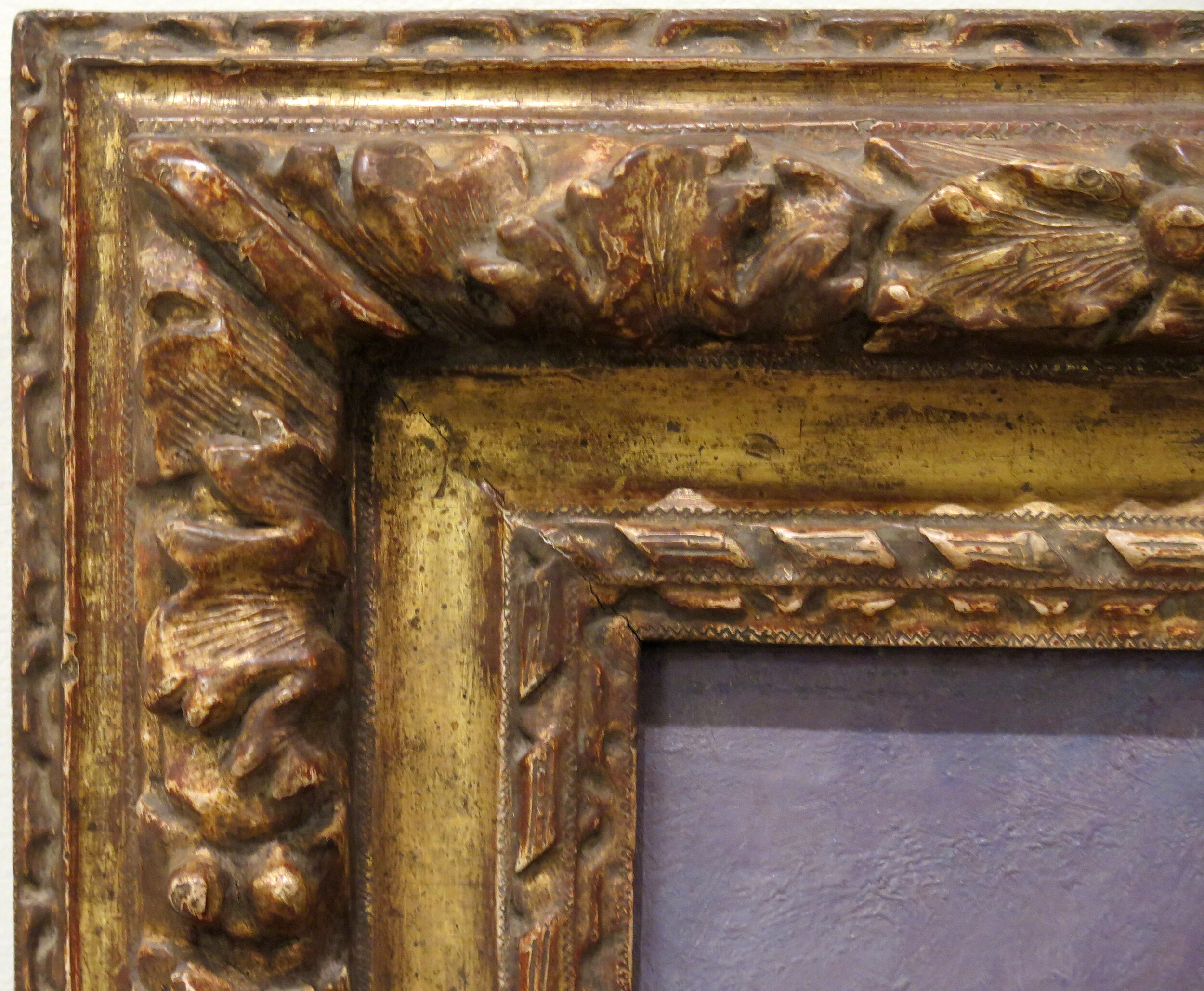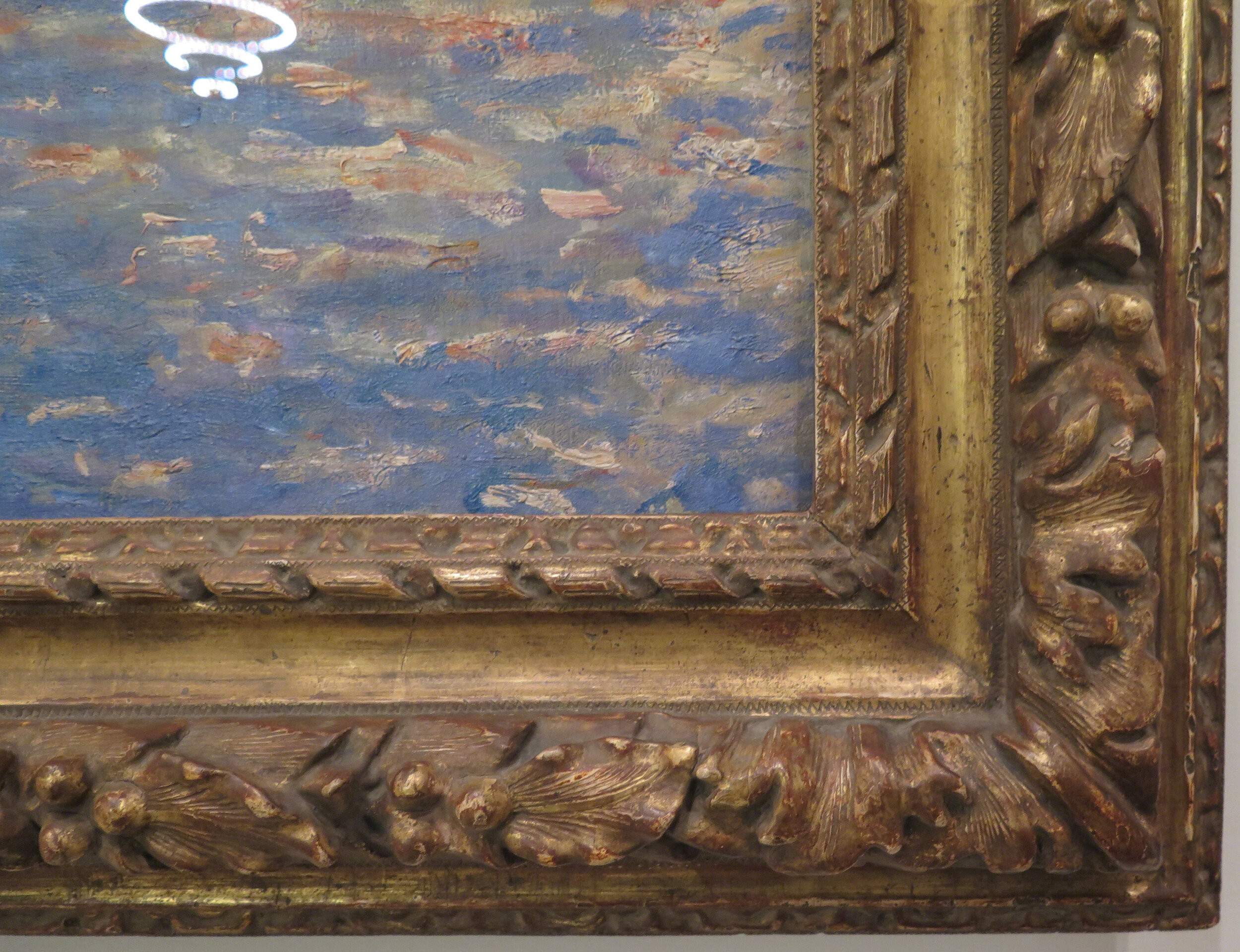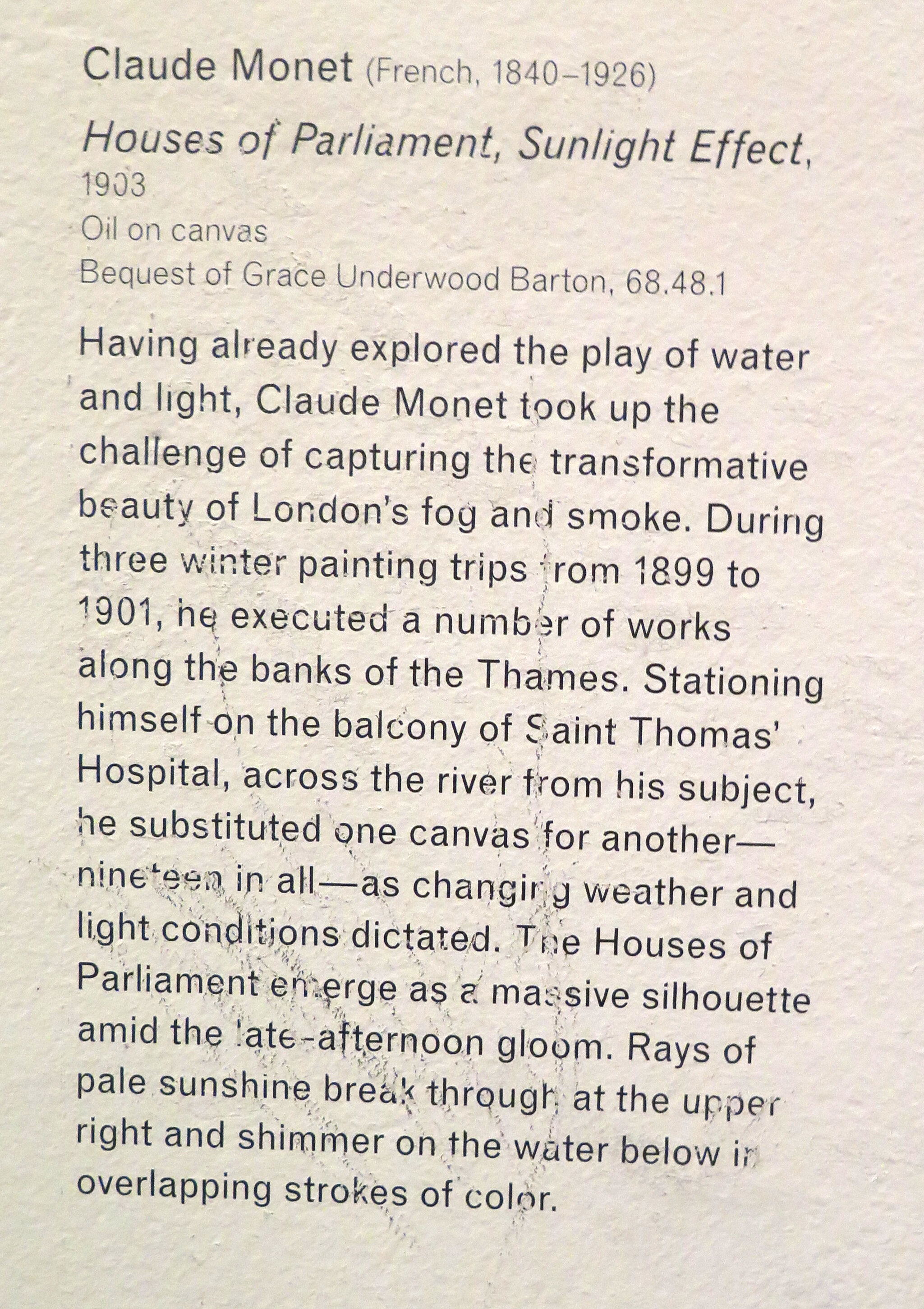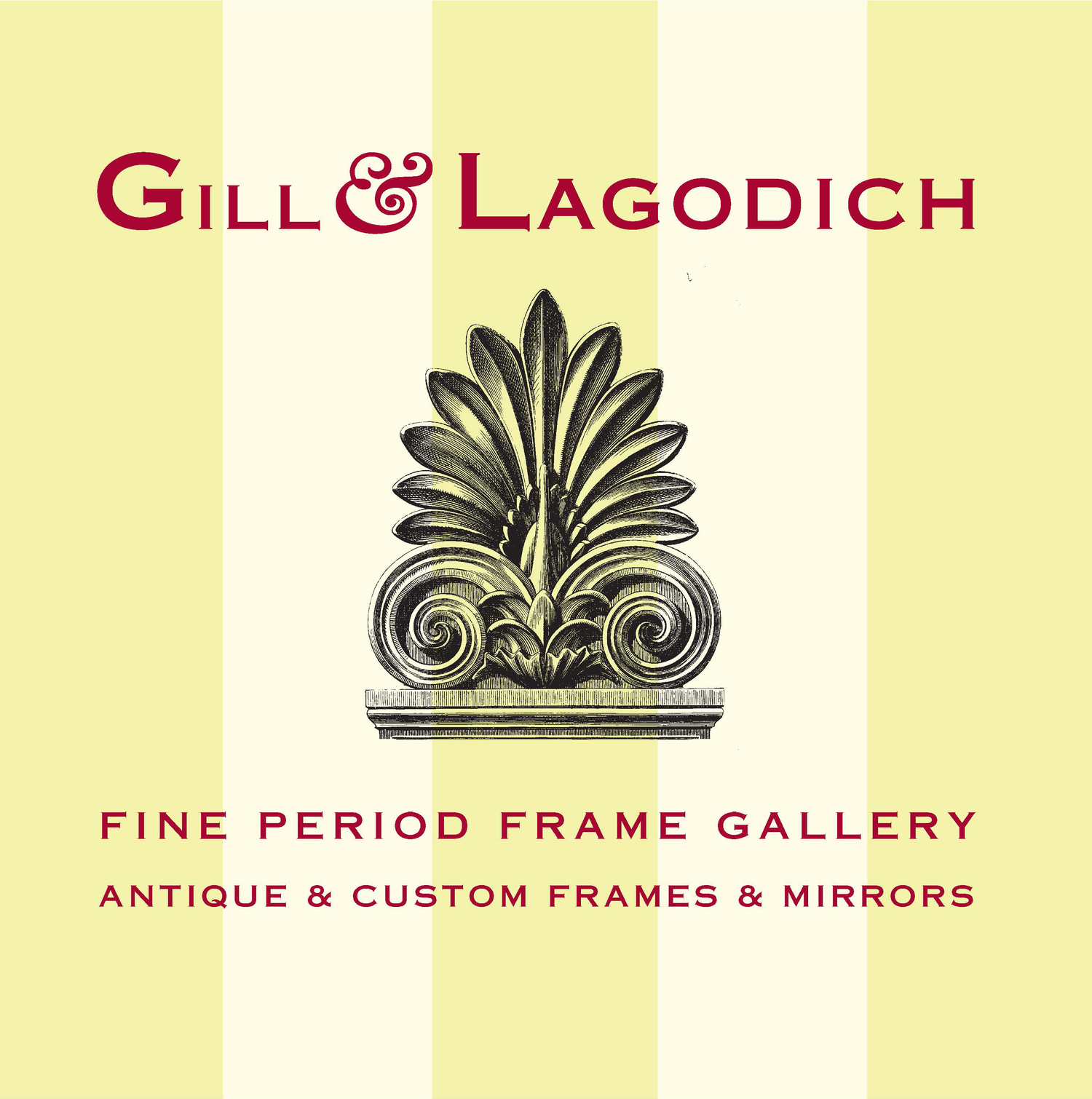BROOKLYN MUSEUM, NEW YORK
Gill & Lagodich has framed American, European, and Russian paintings for the Brooklyn Museum. Selected projects include provision of period frames for paintings (listed alphabetically) by Milton Avery, Striped Shirt, 1932; Sally Avery, Striped Shirt, Striped Cat, 1979; Arnold Bocklin, Roman Landscape, 1852; Agostino Brunias, Free Women of Color With Their Children and Servants in a Landscape, c. 1764-1796; Paul Cézanne, Ville de Gardanne, 1885-86; Jean-Baptiste Corot, Jeune Filles de Sparta; two works by Edgar Degas, Portrait de Mademoiselle Fiocre: à propos du ballet “La Source, 1867-68, and Portrait of A Man, 1866; Gerrit Dou, Self Portait, ca. 1631; Francis Guy, Winter Scene in Brooklyn, 1819-20; Willard Metcalf, Afternoon On The River at Grez, 1884; Henri Matisse, Fleurs, 1906; Claude Monet, Houses of Parliament, Effect of Sunlight, 1903; Claude Monet, Rising Tide at Pourville (Marée montante à Pourville), 1882; Claude Monet, The Islets at Port Villez, 1897; Bartolomeo Veneto, Portrait of a Lady as Mary Magdalen, 1520s.
Custom-made replica frames were fabricated by Gill & Lagodich for the following: John Carroll, Showgirl, 1929; Edgar Degas, Femme au Tub, ca. 1884-86; Gaspard Dughet, (French, 1615-1675), A Traveler On A Path In A Mountainous Landscape; fivec.1882 floral panel paintings by Elizabeth Boott Duveneck; Frans Hals, Portrait of A Man, c. 1614-15; I. Lorser Feitelson, Diana At The Bath, 1922; Viola Pushkarova, Two Ivans and Oksana, 1964; Dwight Tryon, Twilight, 1893-94.
and two monumental canvases by Vasili Vereshchagin, A Resting Place Of Prisoners, 1878-79, andThe Road Of The War Prisoners, 1878-79.
Conservation/Restoration/Sizing of c. 1850s American museum-owned period frames for two paintings by Asher B. Durand, First Harvest in the Wilderness, and Birch and Oaks.Conservation of original gilded wood frame for José Campeche, Doña María de los Dolores Gutiérrez del Mazo y Pérez, ca. 1796. Conservation of two frames original to Charles Balthazar Julien Févret de Saint-Mémin: James Alexander Fulton of Mount Erin and Elizabeth Bland Mayo Fulton of Powhattan Seat
The Gill & Lagodich design, adaptation and fabrication of a period frame style described in Pissarro’s letters, for the Camille Pissarro painting, “The Climbing Path, L'Hermitage, Pontoise” [The Climb, Rue de la Côte-du-Jalet, Pontoise (Chemin montant, rue de la Côte-du-Jalet, Pontoise)], 1875, merited a 6-page article, FRAME GAME, in The New Yorker magazine (written by Leo Carey, March, 27, 2006), and was exhibited at the Museum of Modern Art, New York City; Los Angeles County Museum of Art, and Musée d’Orsay, Paris.
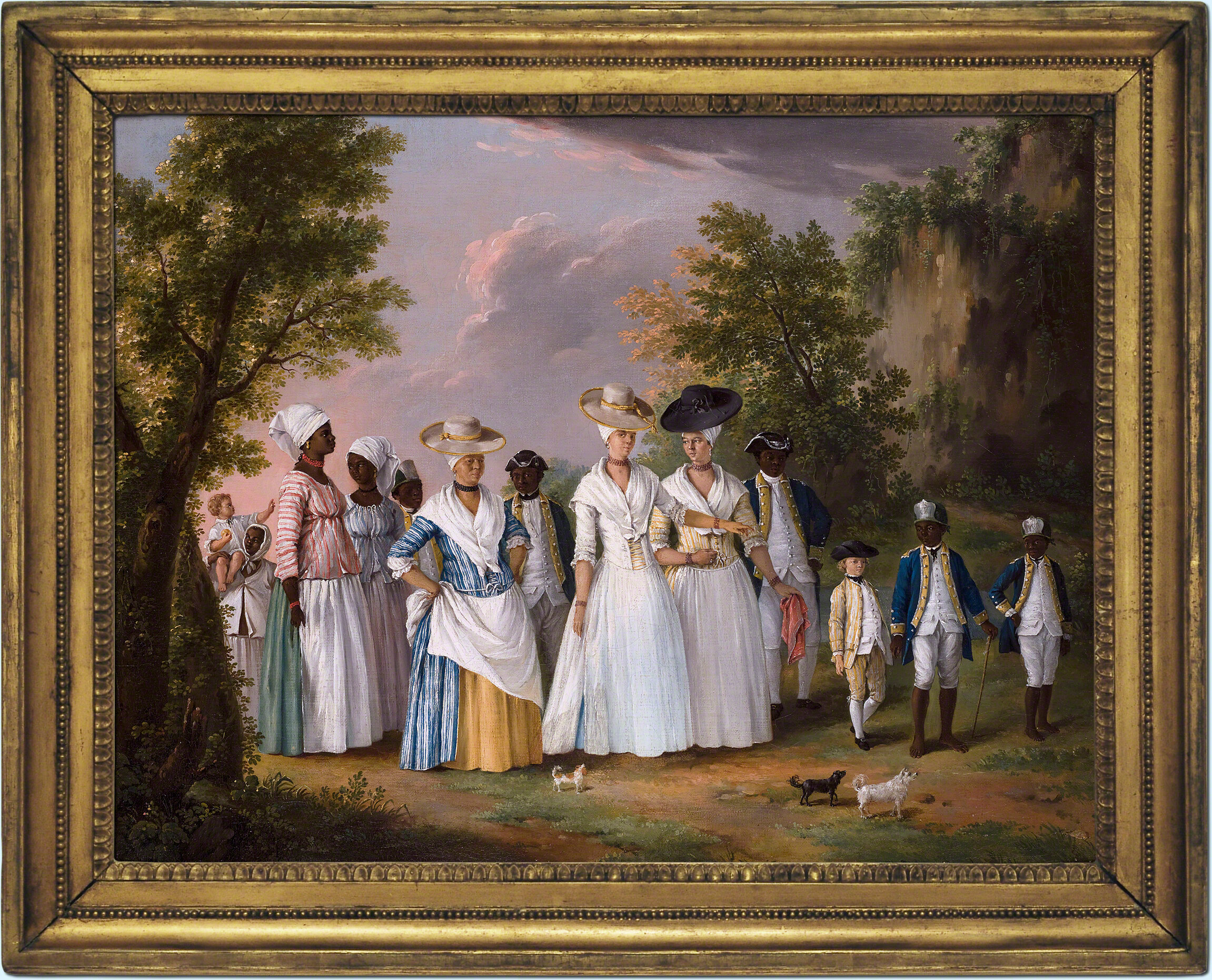
AGOSTINO BRUNIAS (ca. 1730–1796)
Free Women of Color with Their Children and Servants in a Landscape, ca. 1770-1796, oil on canvas, 20 x 26 1/8 in. (50.8 x 66.4 cm). Period frame, 19th century French, gilded carved wood and applied composition ornament, molding width 2-7/8 in.“Here, on the grounds of a Caribbean sugar plantation, two luxuriously dressed mixed-race sisters enjoy a walk with their mother, children, and eight African servants. After the Seven Years’ War (1754–63), the British government sent the Roman painter Agostino Brunias to Dominica, one of its newly acquired Caribbean territories. Although Brunias was originally commissioned to promote upper-class plantation life, his paintings soon exposed the artificialities of the region’s racial hierarchies.” —Museum label. Brooklyn Museum, Gift of Mrs. Carll H. de Silver in memory of her husband, by exchange and gift of George S. Hellman, by exchange, 2010.59
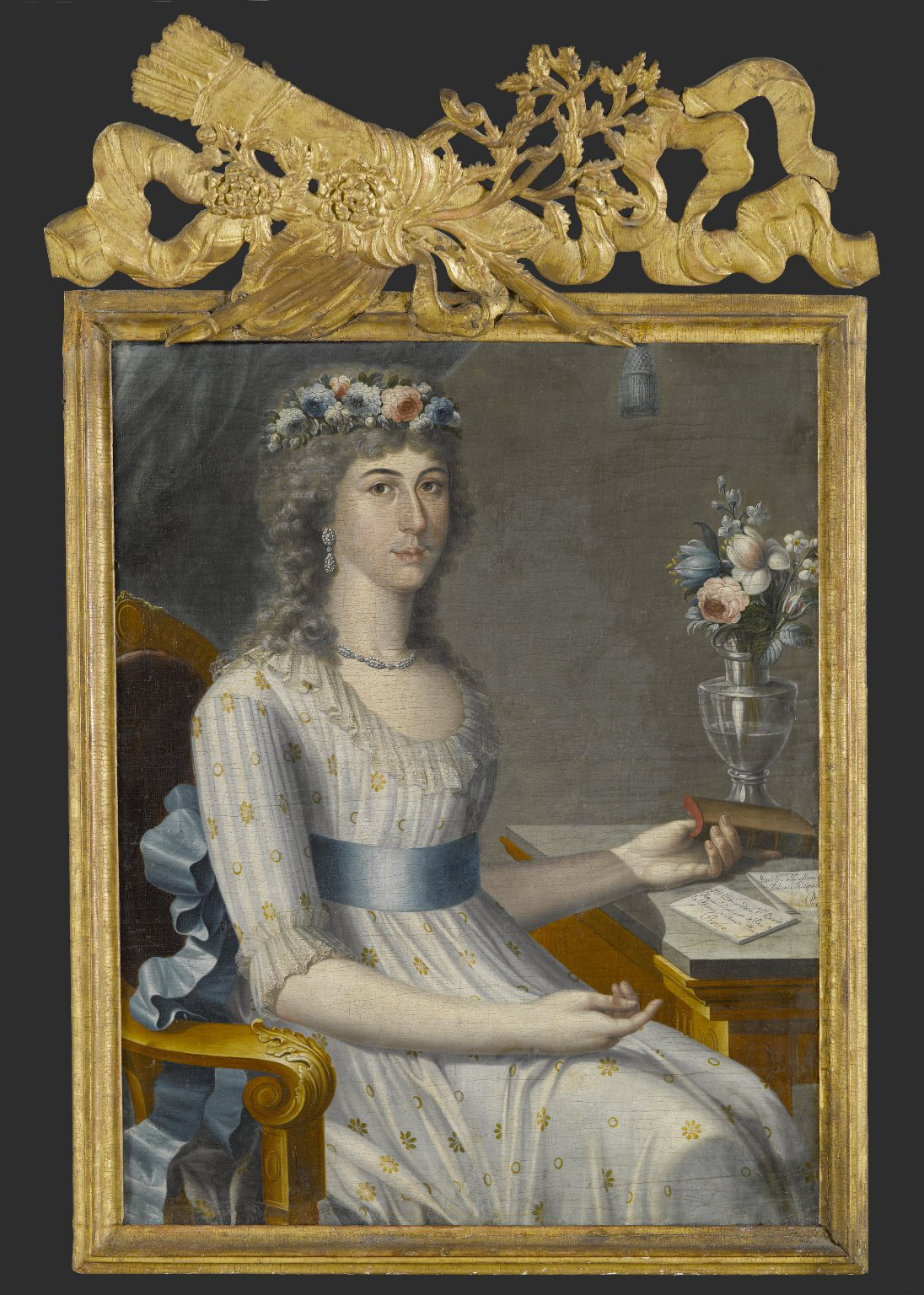
JOSE CAMPECHE (1751–1809)
Doña María de los Dolores Gutiérrez del Mazo y Pérez, ca. 1796. Oil on canvas, 32 11/16 x 26 in. (83 x 66 cm). Gilded hand-carved wood frame, possibly original to the painting, extensive woodwork and structural conservation by Gill & Lagodich for the Brooklyn Museum, 2012. “José Campeche depicted Doña María de los Dolores, a member of Puerto Rico’s Spanish colonial elite, in a fashionably informal dress around the time of her marriage to Don Benito Pérez, a fellow Spaniard and the future viceroy of New Granada. Campeche was the island’s celebrated portrait and religious painter. His father was an enslaved Puerto Rican of African heritage who purchased his freedom after working as a painter and gilder, and his mother was a white Spanish woman.” —Museum label. Brooklyn Museum, Gift of Lilla Brown in memory of her husband, John W. Brown, by exchange, 2012.45 (Photo: Brooklyn Museum, 2012.45_PS6.jpg)
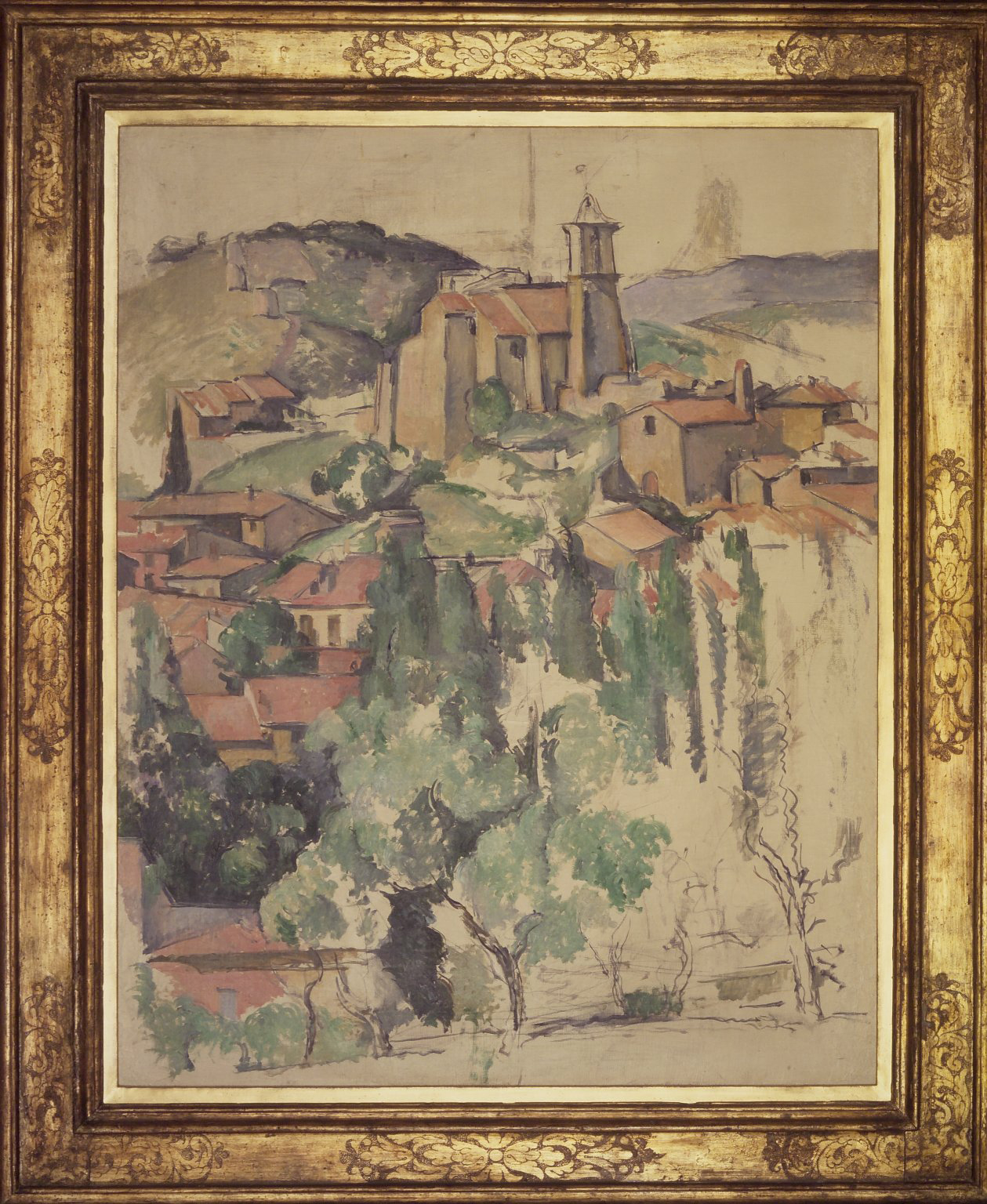
PAUL CÉZANNE (1839 – 1906)
Le Village de Gardanne, 1885-1886, oil and conté crayon on canvas, 36-1/4" x 28-13/16". 16th-century Spanish frame, cassetta profile, gilded hand-carved wood, punched foliate decoration, molding width 5-1/2 in. "Cézanne juxtaposes the blocky geometries of the townscape with the curling organic forms of rolling hills and vegetation. The shifting planes of the angular roofs and subtly shaded façades anticipate the experiments of the Cubists in the early twentieth century. Cézanne investigates tone as well as form, matching the warm ochers, oranges, and reds of the architecture with the cool, smoky blue-green of the foliage. An unfinished work with large visible expanses of a cream base coat, this picture provides insight into Cézanne’s working process, with traces of graphite underdrawing and tentative squiggles of black paint." —Brooklyn Museum, Ella C. Woodward Memorial Fund and Alfred T. White Fund, 23.105
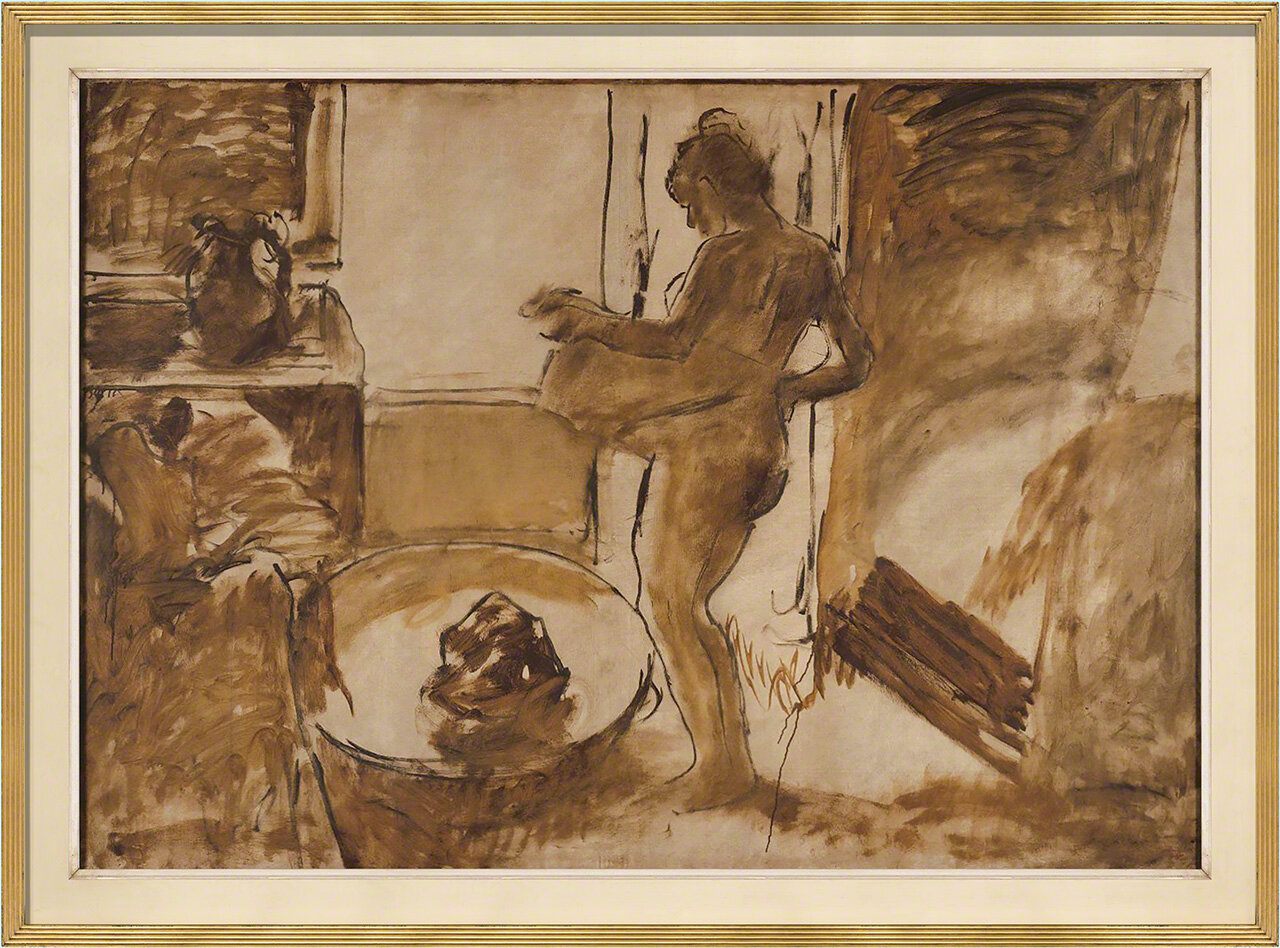
EDGAR DEGAS
Nude Woman Drying Herself (Femme au Tub), ca. 1884-1886, oil on canvas, 59 3/8 x 84 1/8 in. (150.8 x 213.7 cm). Custom-made replica 19th-century French Degas-designed painting frame; chemin-de-fer profile as sketched in Degas’ notebooks; milled and gilded wood with patinated gesso frieze, molding width: 4-5/8” Embracing the Impressionist credo of painting modern life, Degas concentrated on the daily rituals of urban dwellers. In this image, typical of his bather scenes, Degas captures his subject from behind and in motion as she vigorously towels herself after a bath. Bright light pours in from the window, highlighting her left breast but otherwise casting her body in shadow and limiting clear definition of both facial and bodily features. This composition thus denies much of the erotic charge associated with more traditional images of the passive female nude. As many have noted, however, the furnished domestic interior suggests an unusually intimate glimpse into the routines of a bourgeois woman—a candid view that challenged the proprieties of that class at the time. Unlike his fellow Impressionists, Degas remained devoted to more traditional working methods, including the execution of numerous preliminary drawings for finished works. The summary definition of form, quick brushstrokes, and monochromatic sepia tones suggest that this work may be the under-drawing for an ambitious but unfinished painting.” —museum text. Painting, Brooklyn Museum, Carll H. de Silver Fund, 31.813
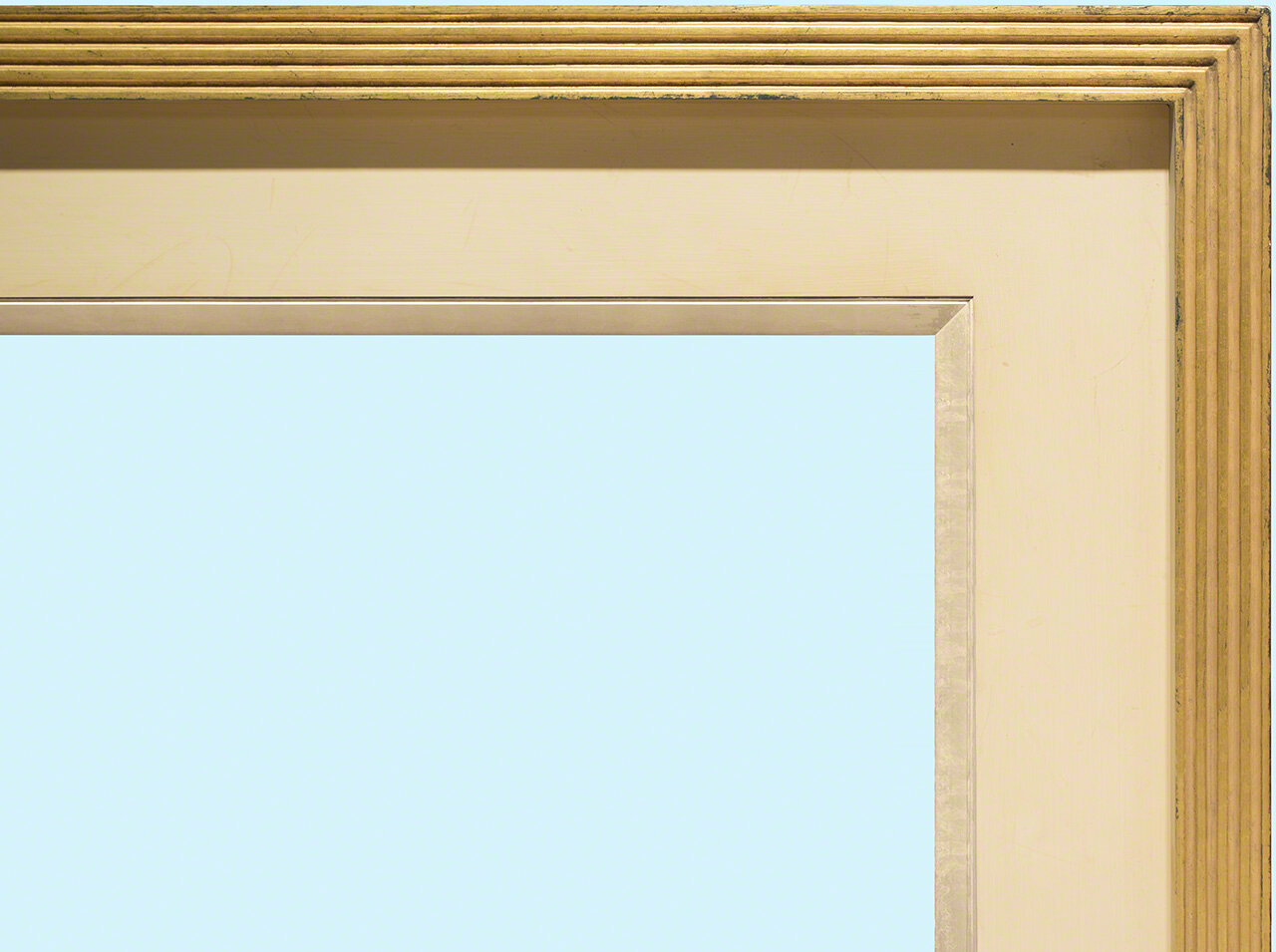
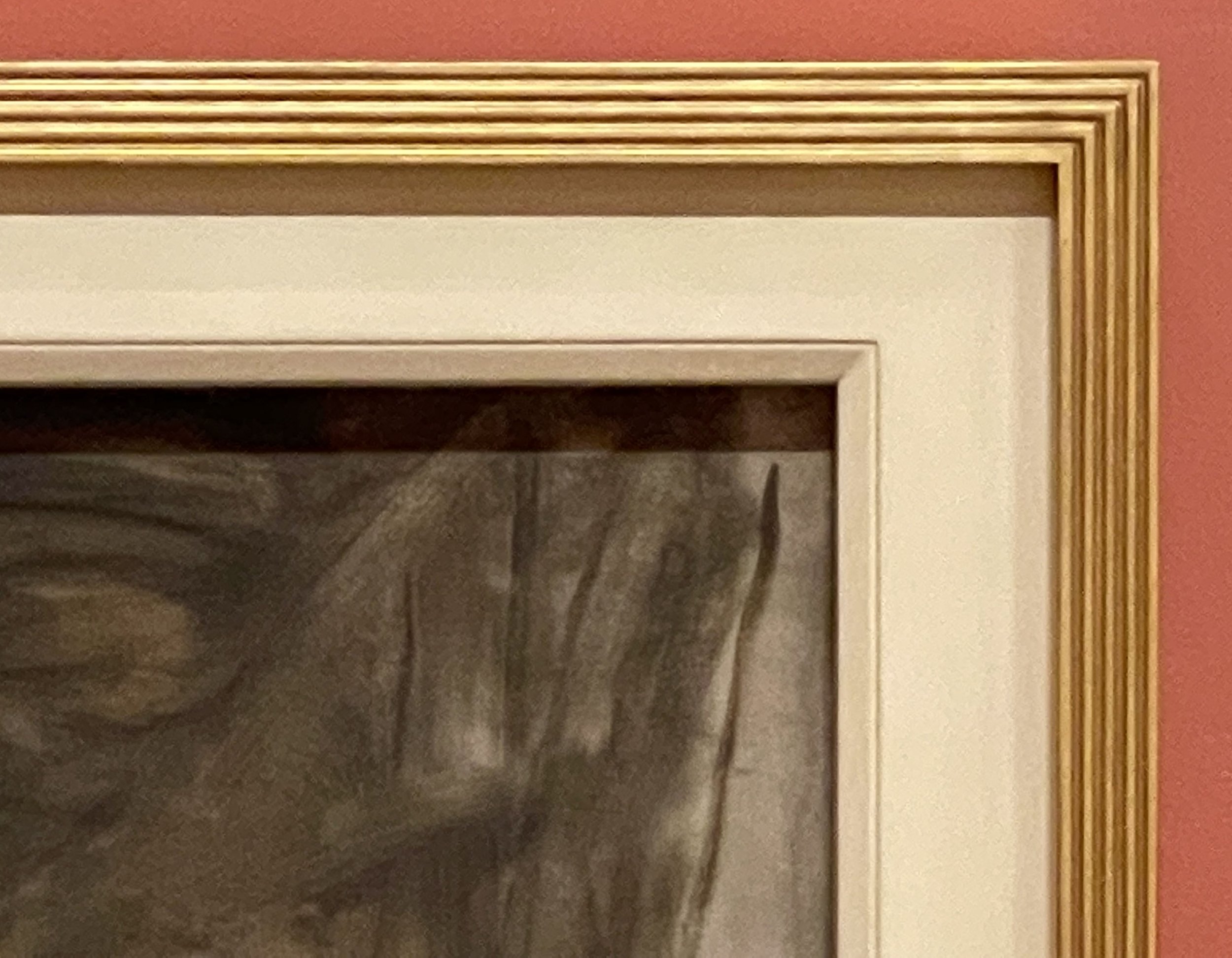
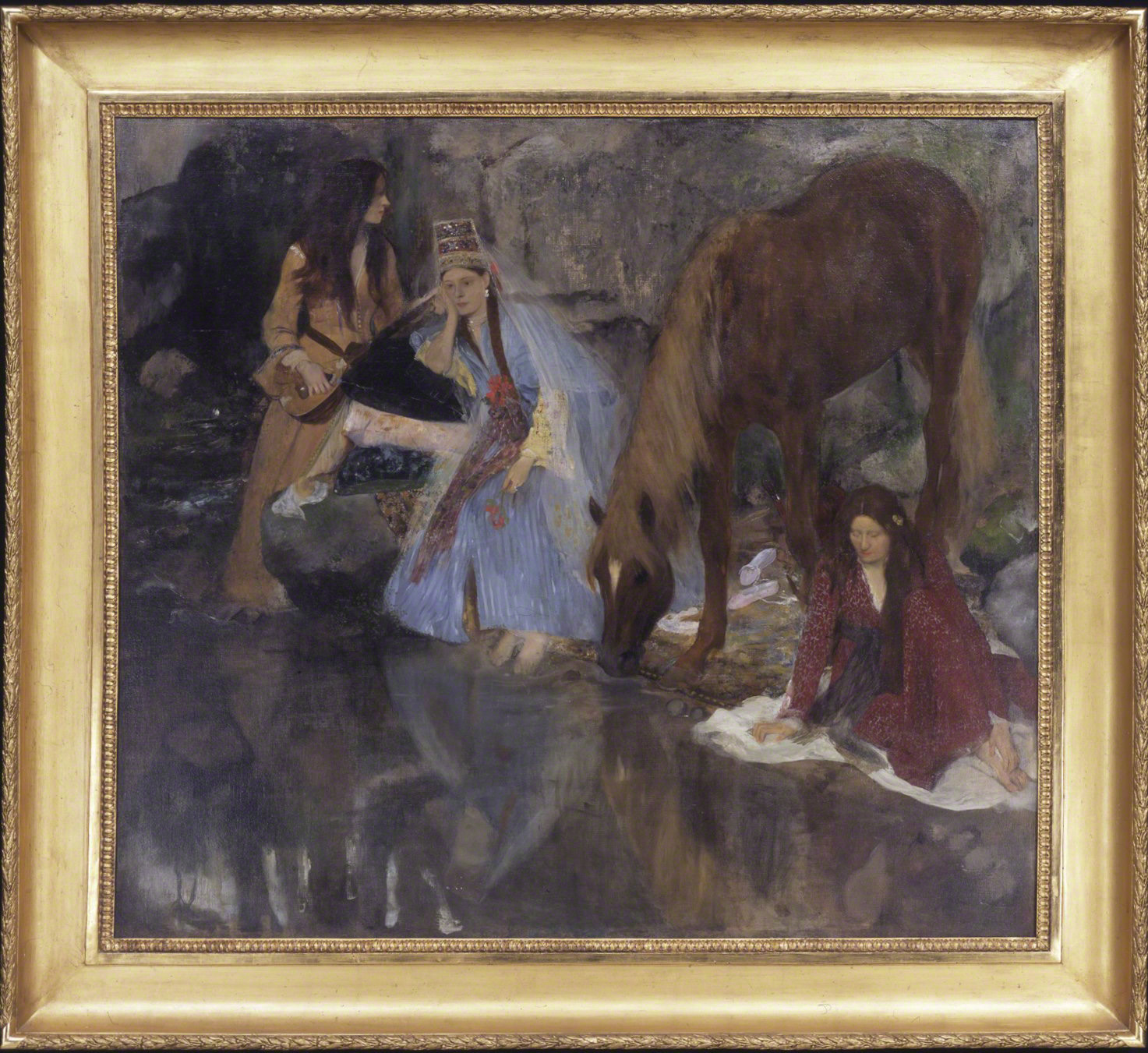
EDGAR DEGAS (1834–1917)
“Portrait of Mlle Fiocre in the Ballet "La Source" (Portrait de Mlle...E[ugénie] F[iocre]: à propos du ballet "La Source"),” ca. 1867–1868, oil on canvas, 51-1/2” x 57-1/8”, Brooklyn Museum, Gift of James H. Post, A. Augustus Healy, and John T. Underwood, 21.111 (Photo: Brooklyn Museum, 21.111_framed_SL4.jpg) Framed by Gill & Lagodich, 19th-century French molding frame; gilded applied ornament on wood, original gilding and patina, molding width: 7"
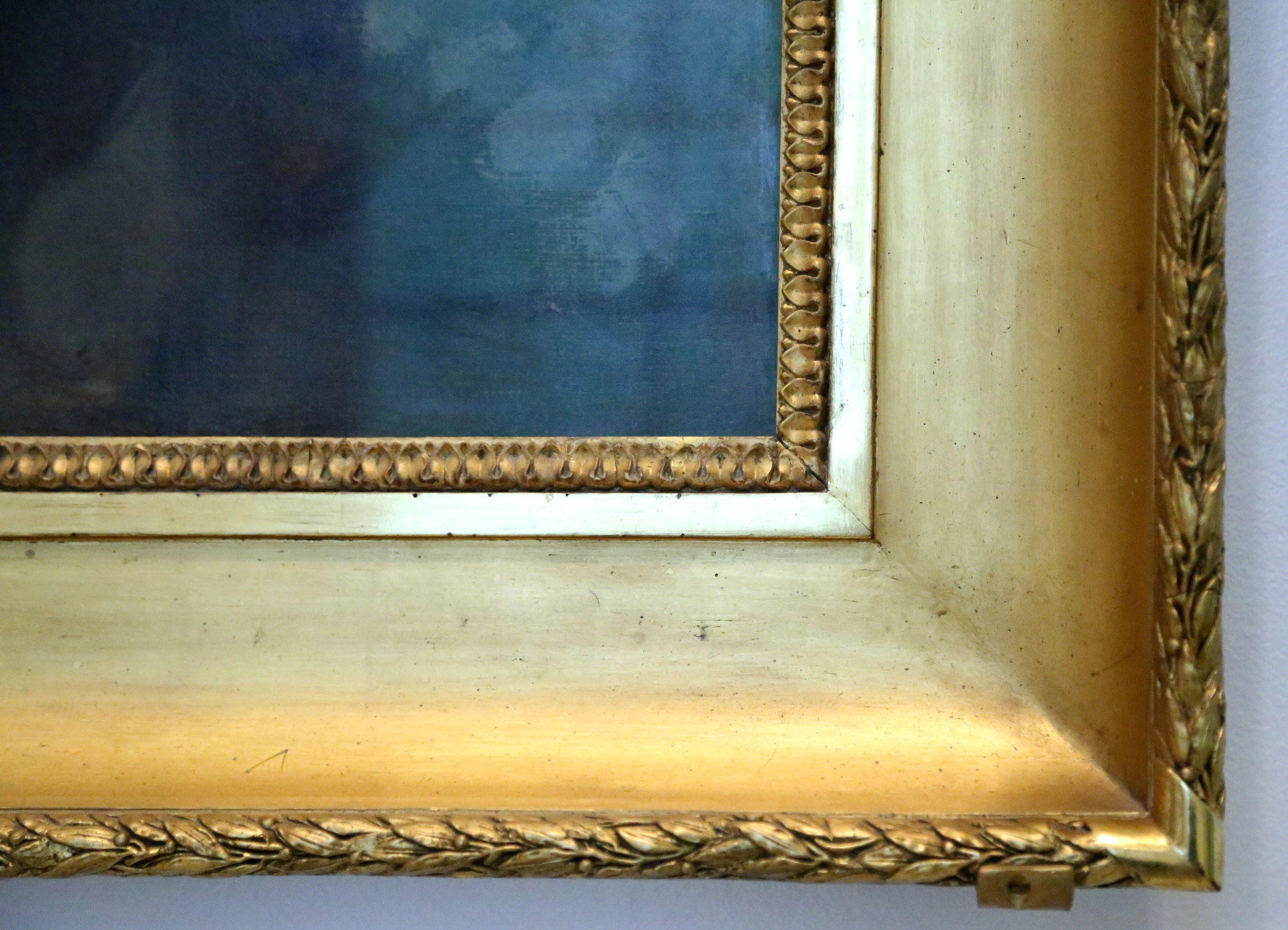
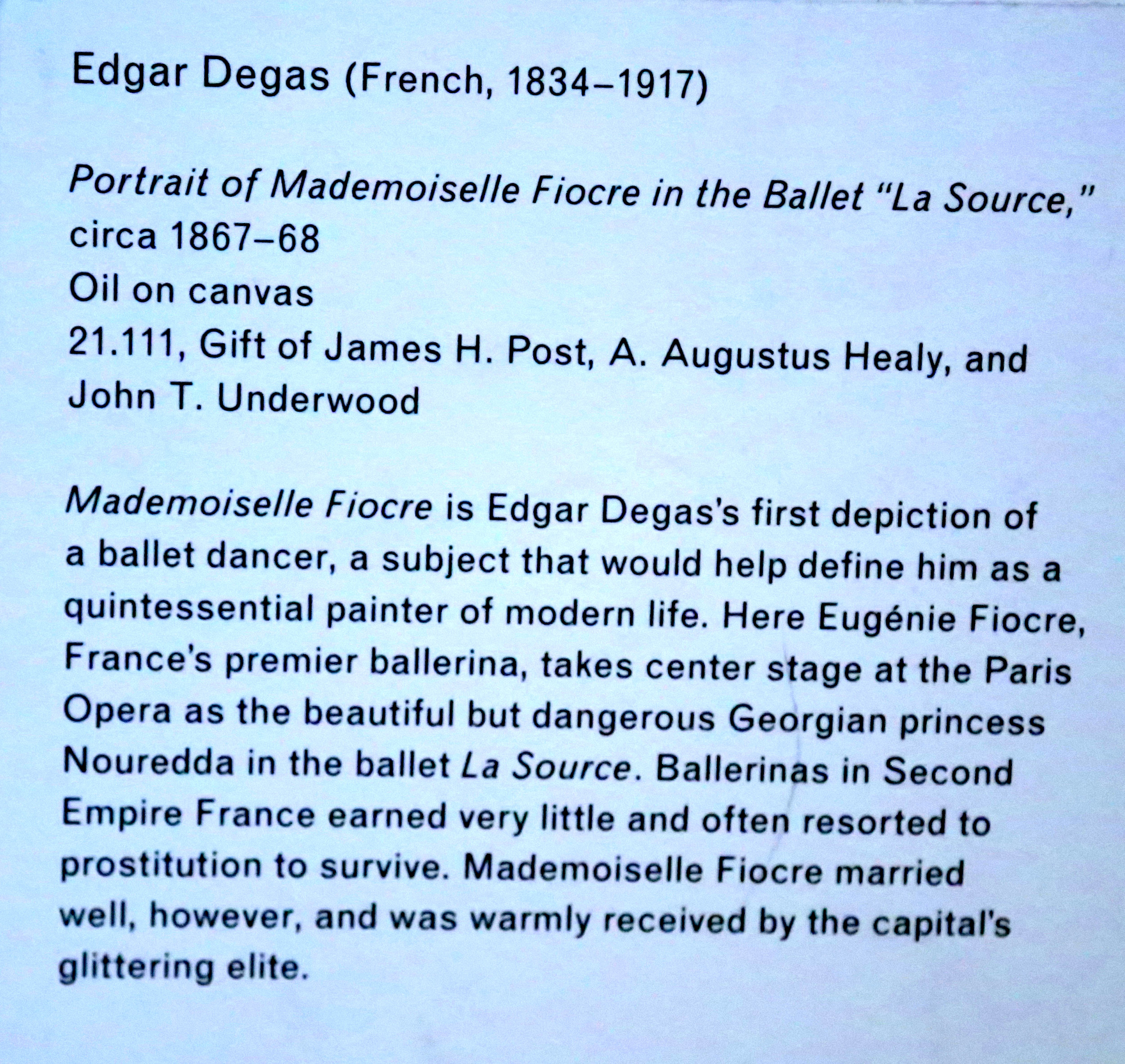
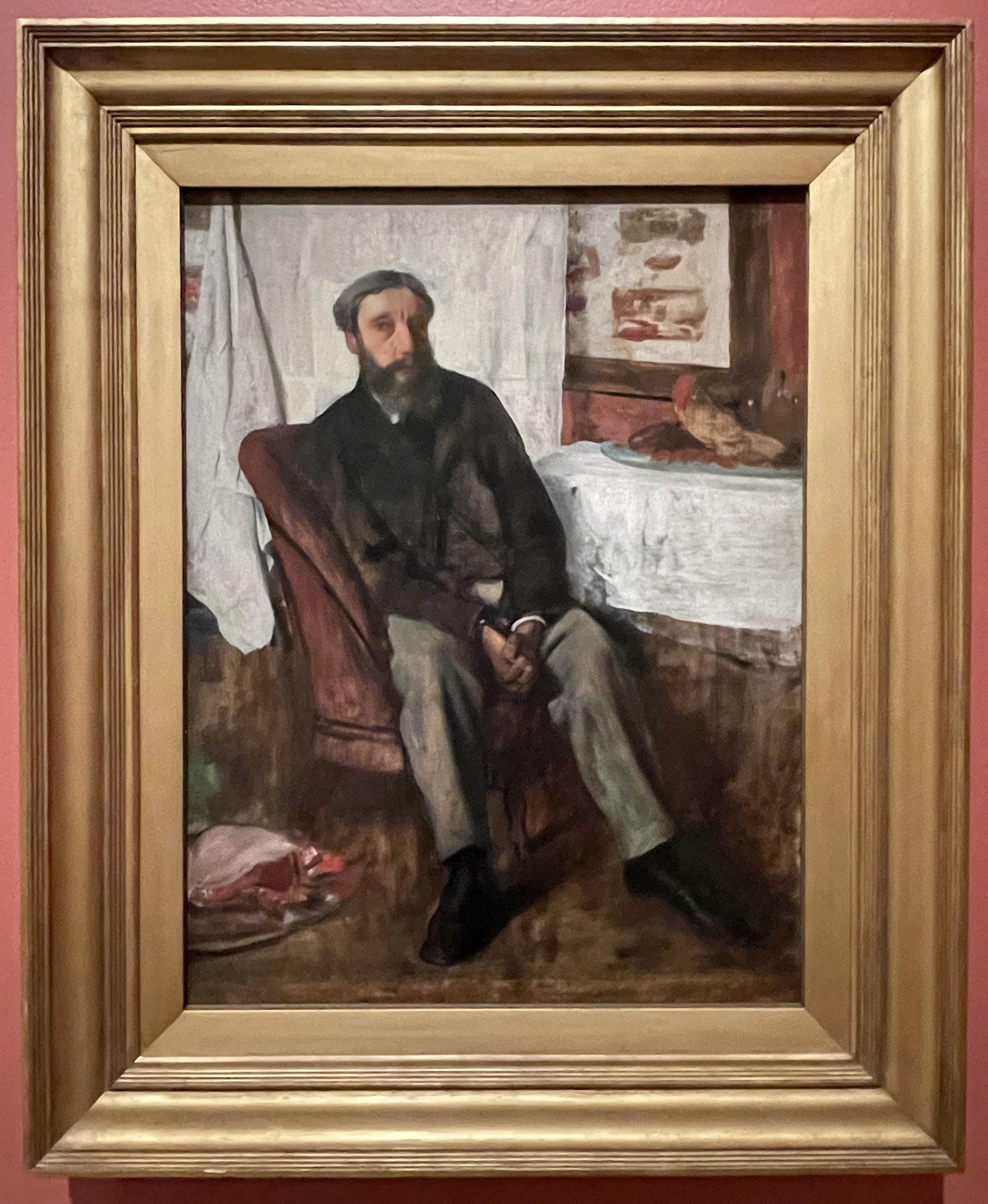
EDGAR DEGAS (1834–1917)
Portrait of A Man (Portrait d’homme), ca. 1866, oil on canvas, 34 x 25-5/8 in. Period 19th-century French frame, molding width 5-5/8 in. Museum Collection Fund, 21.112
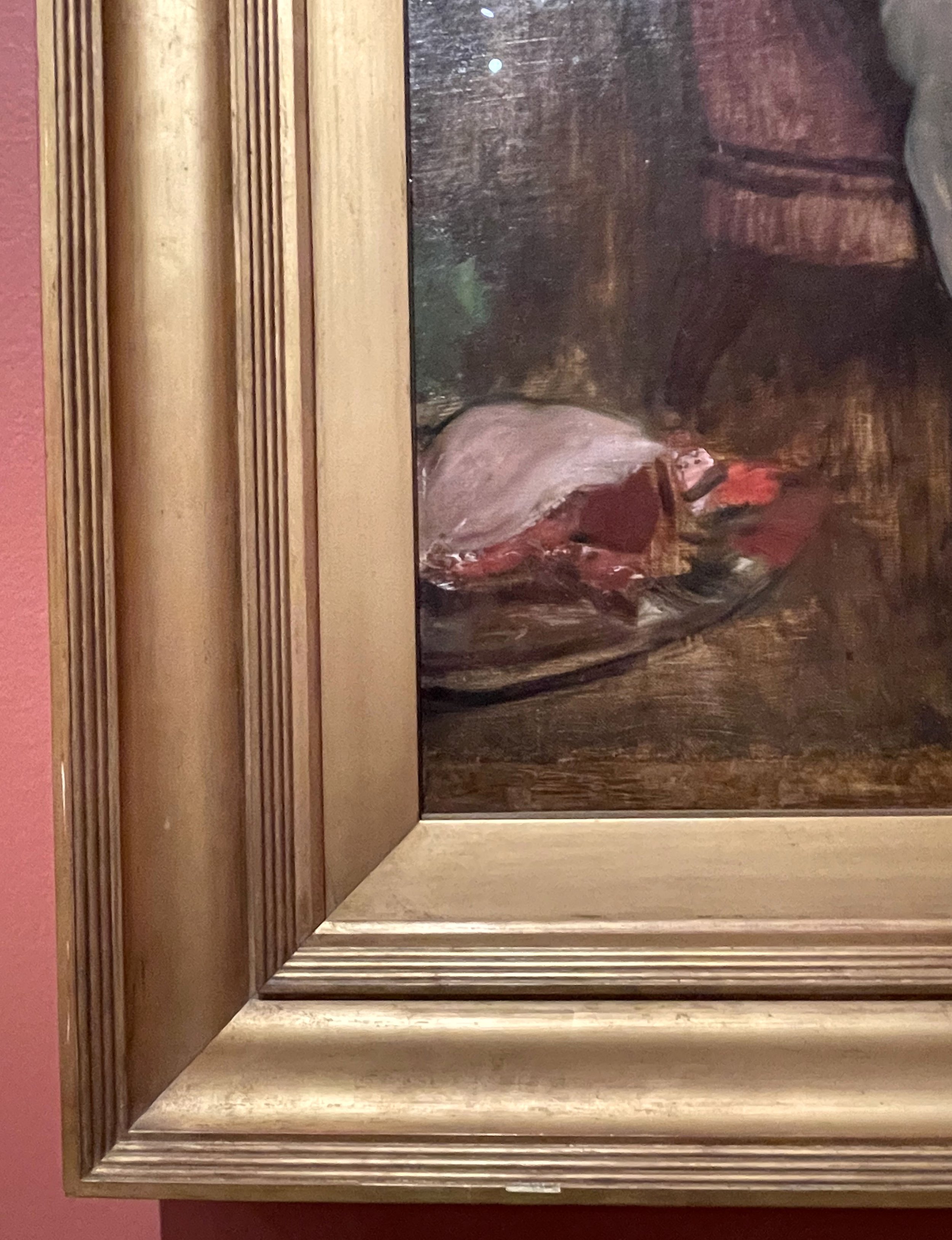
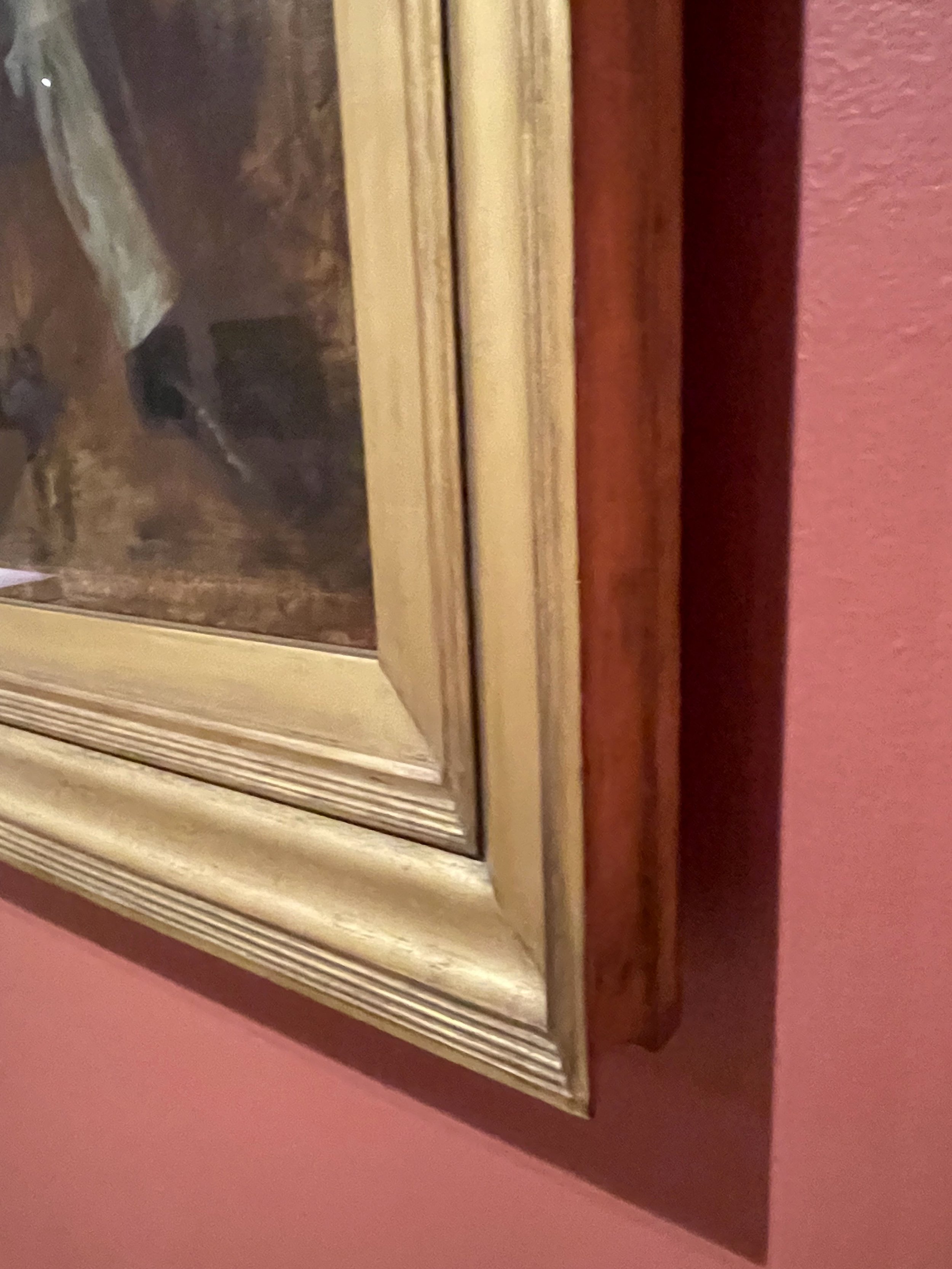
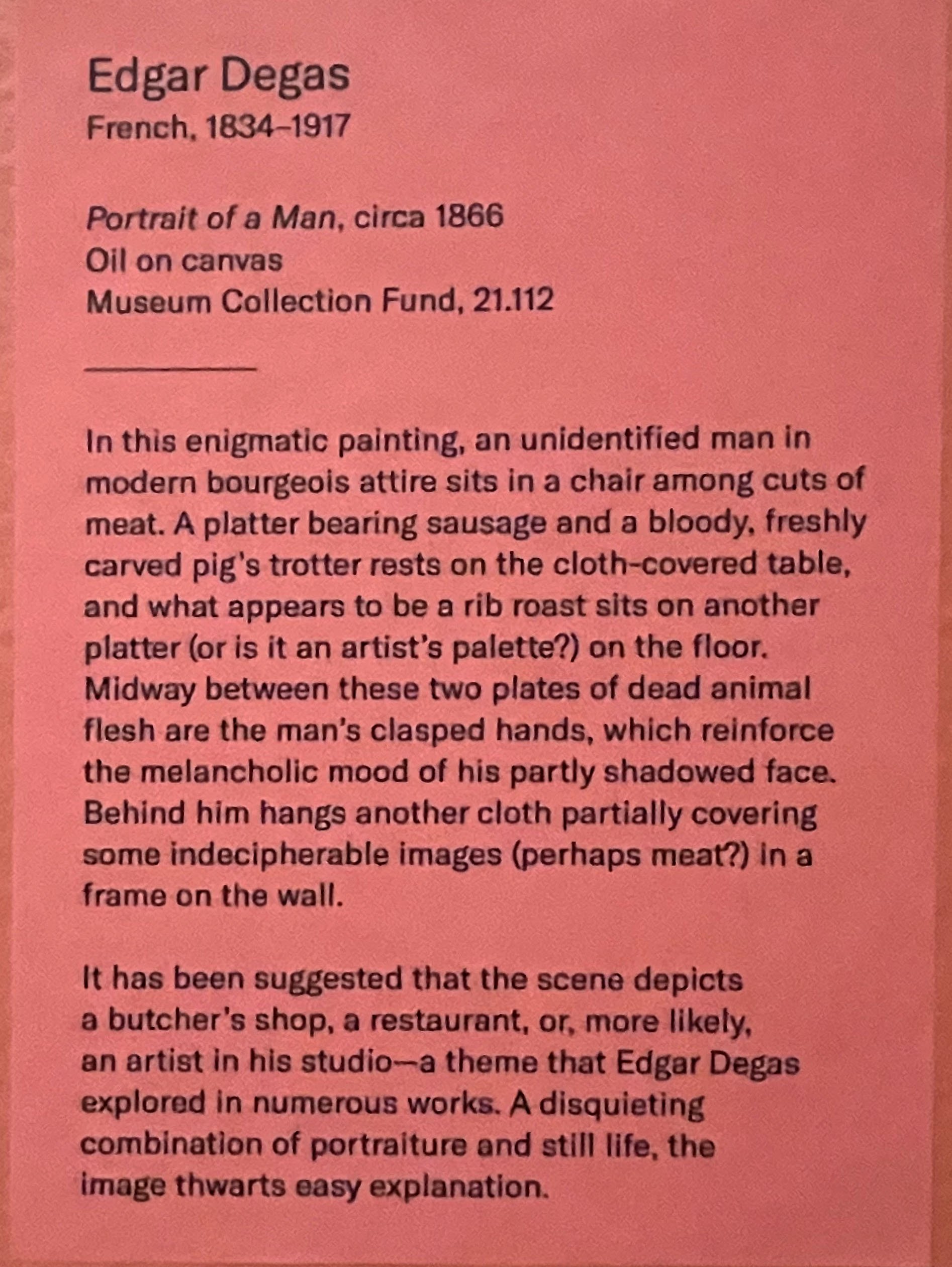
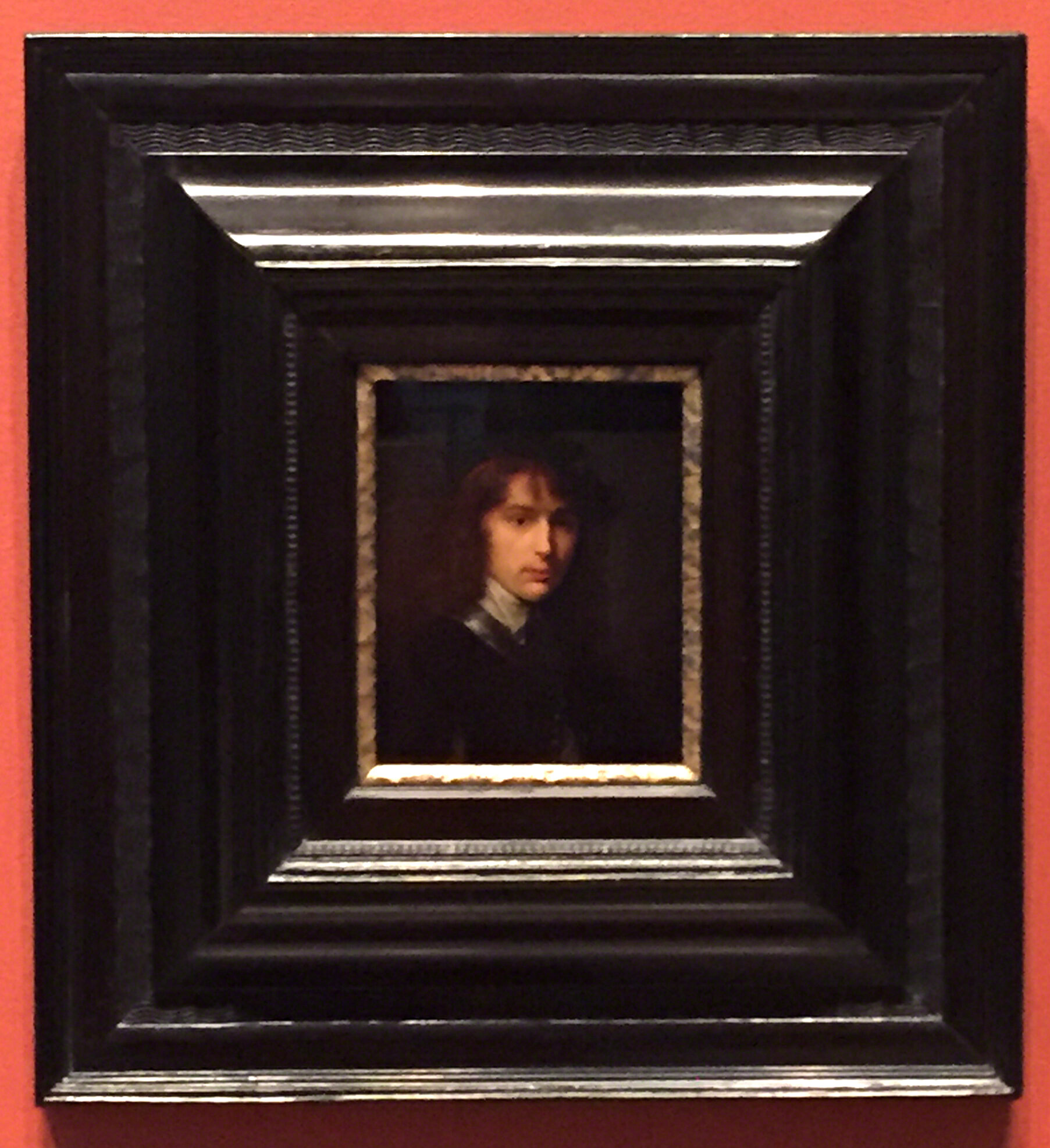
GERRIT DOU (1613–1675)
Self-Portrait, ca. 1631, oil on panel, 6-3/16 × 4-15/16 × 1/8 in. (15.7 × 12.5 × 0.3 cm); 19th-century Dutch-style Alpine ebonized wood frame, molding width 5-12 in. Painting, gift of the executors of the Estate of Colonel Michael Friedsam, 32.784
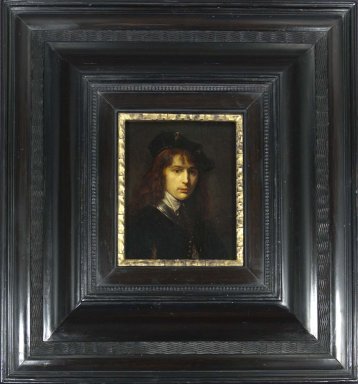
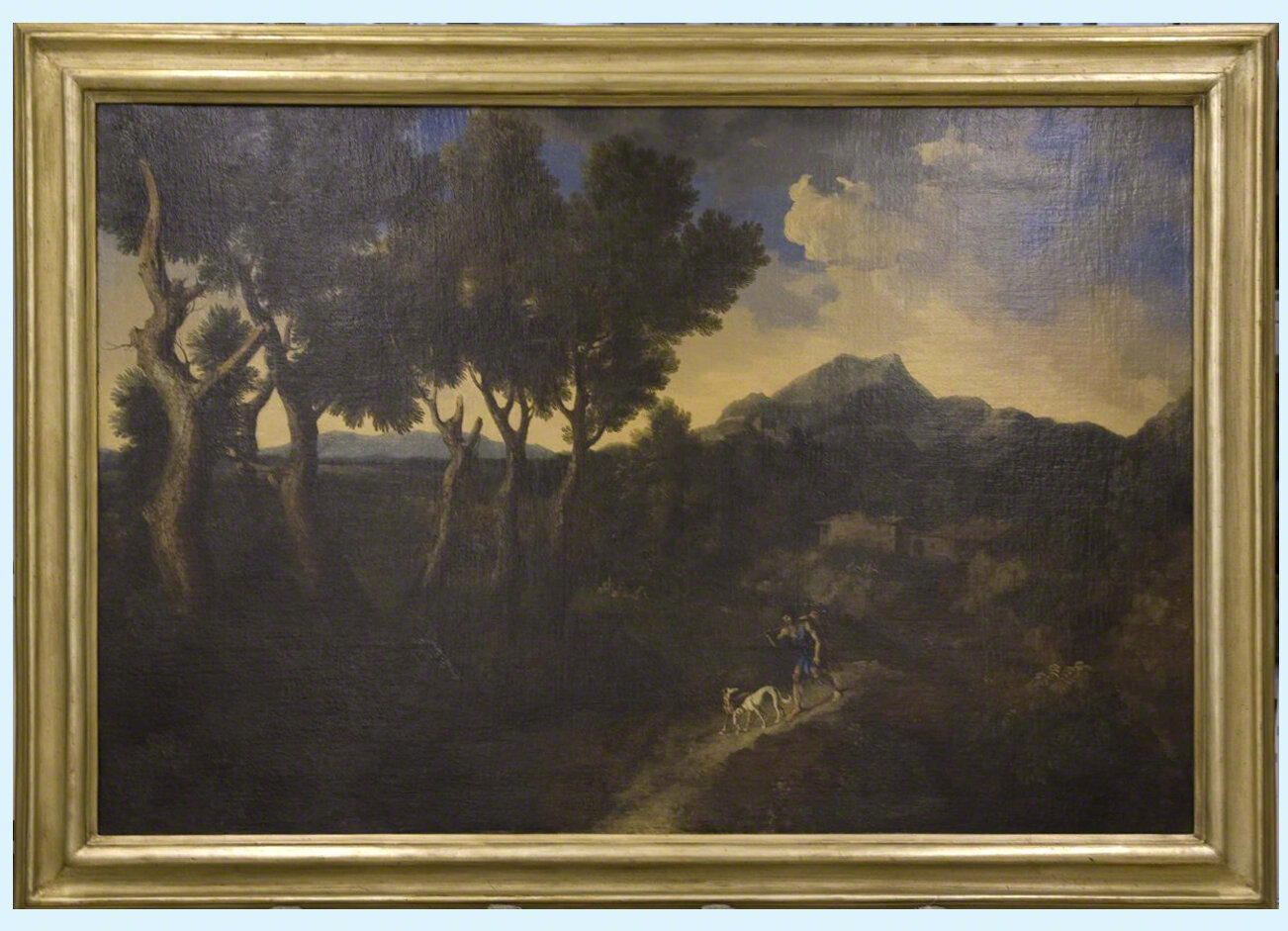
GASPARD DUGHET (1615–1675)
A Traveler on a Path in a Mountainous Landscape, ca. 1640, oil on canvas, 35-5/8 x 52-5/16. Custom hand-carved and gilded replica of c. 17th-century French reverse profile painting frame, molding width: 4-1/8” Brooklyn Museum, Joseph F. McCrindle Collection, 2009.35.1

ASHER BROWN DURAND (1796—1886)
First Harvest in the Wilderness, 1855, oil on canvas, 31-5/8 x 48-1/16 in. Original 1850s American frame, gilded applied composition ornament and stenciled sandwork on wood, restored by Gill & Lagodich. “Although not a scene of the American West, this painting can be interpreted within the context of the artistic perpetuation of the notion of Manifest Destiny. Here the American wilderness yields to progress as a lone farmer reaps his first harvest in a field, still dotted with the stumps of recently cleared trees. A boulder resting by the side of the road identifies him by name as “Graham.” Using funds bequeathed by one of its founders, Augustus Graham, the Brooklyn Museum commissioned Asher B. Durand to paint this work in 1855, thus officially establishing its collection of American art. Durand’s dramatic landscape pays tribute to Graham’s efforts as a cultural pioneer.” —museum label
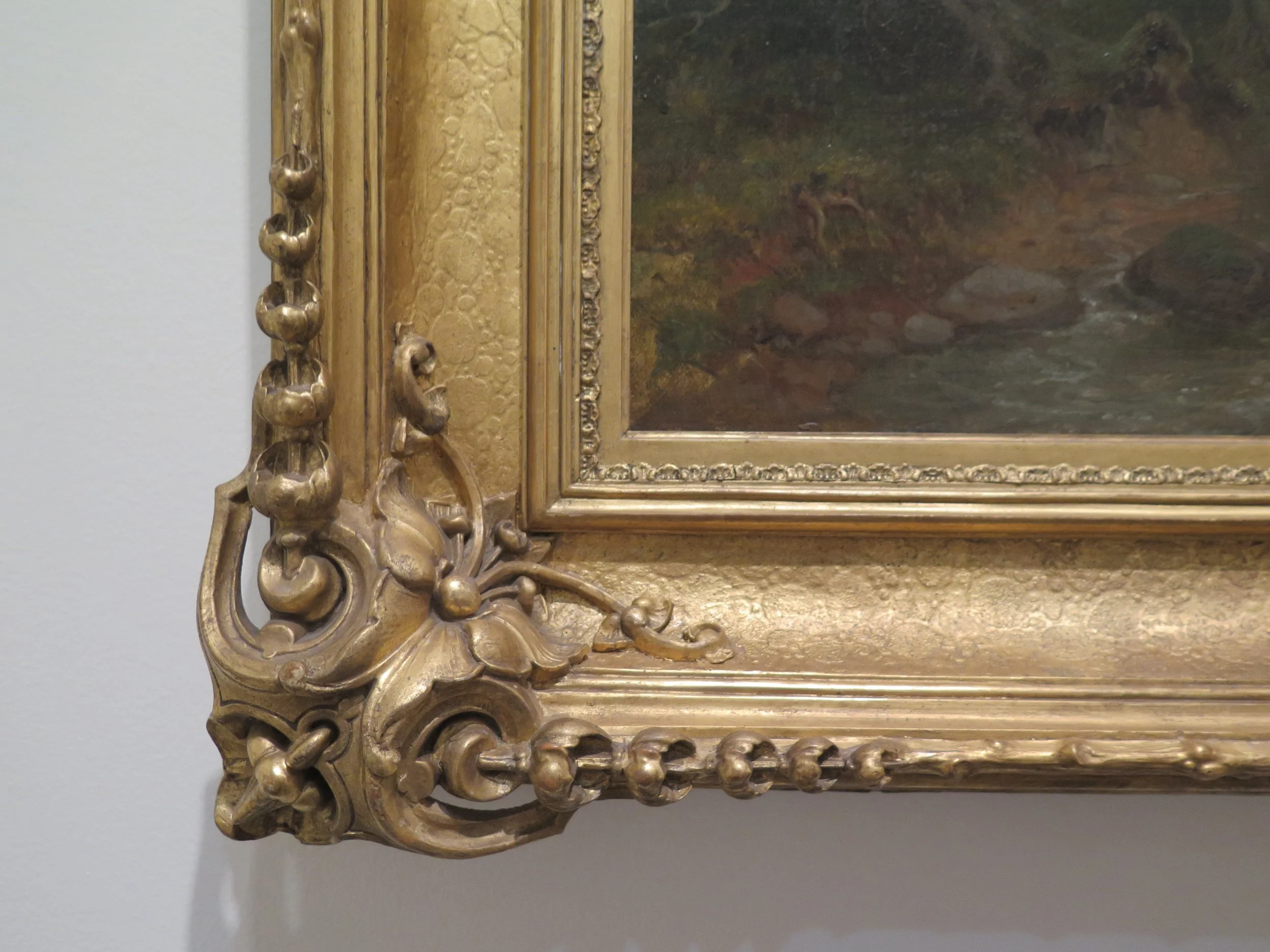
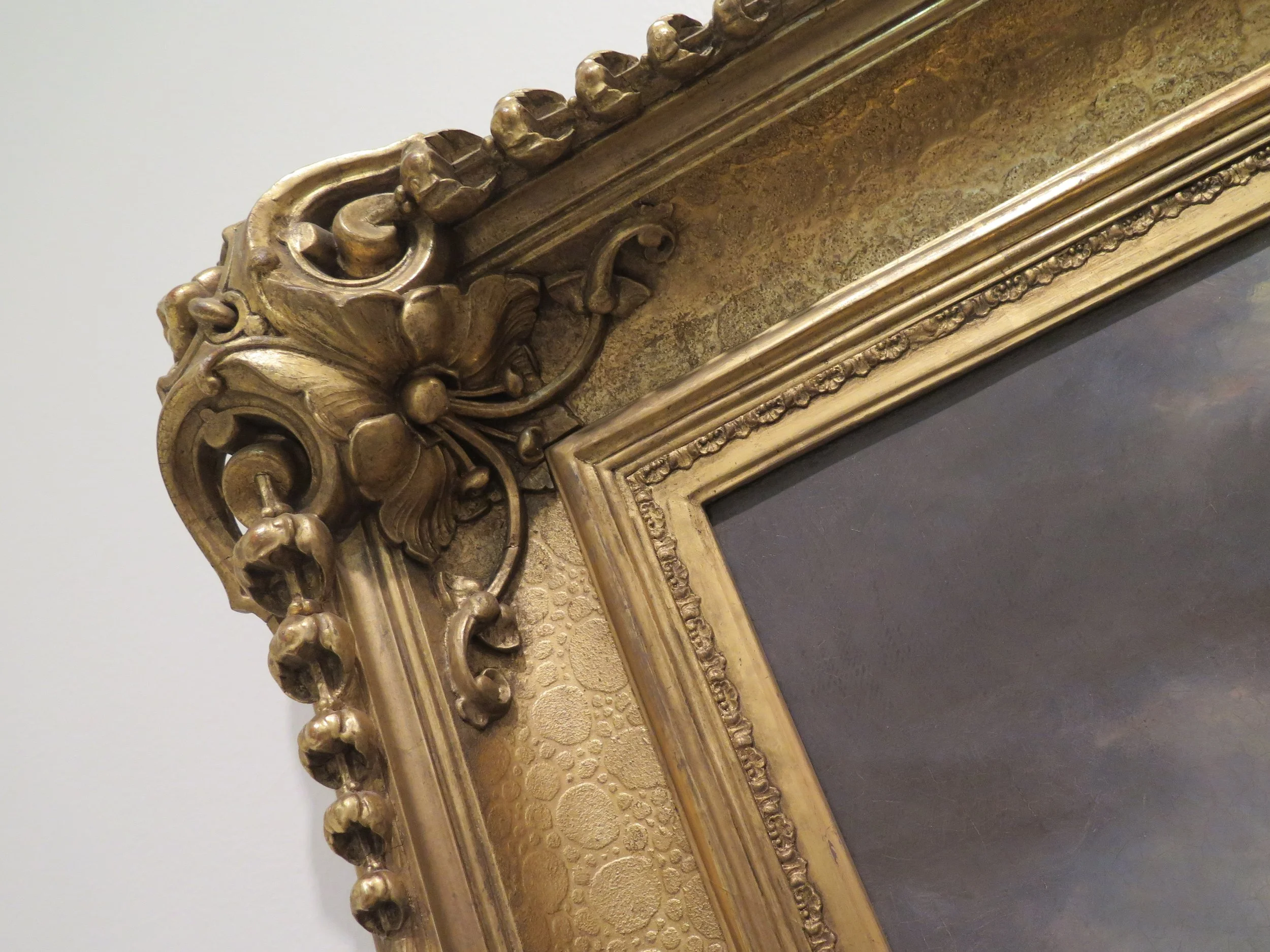
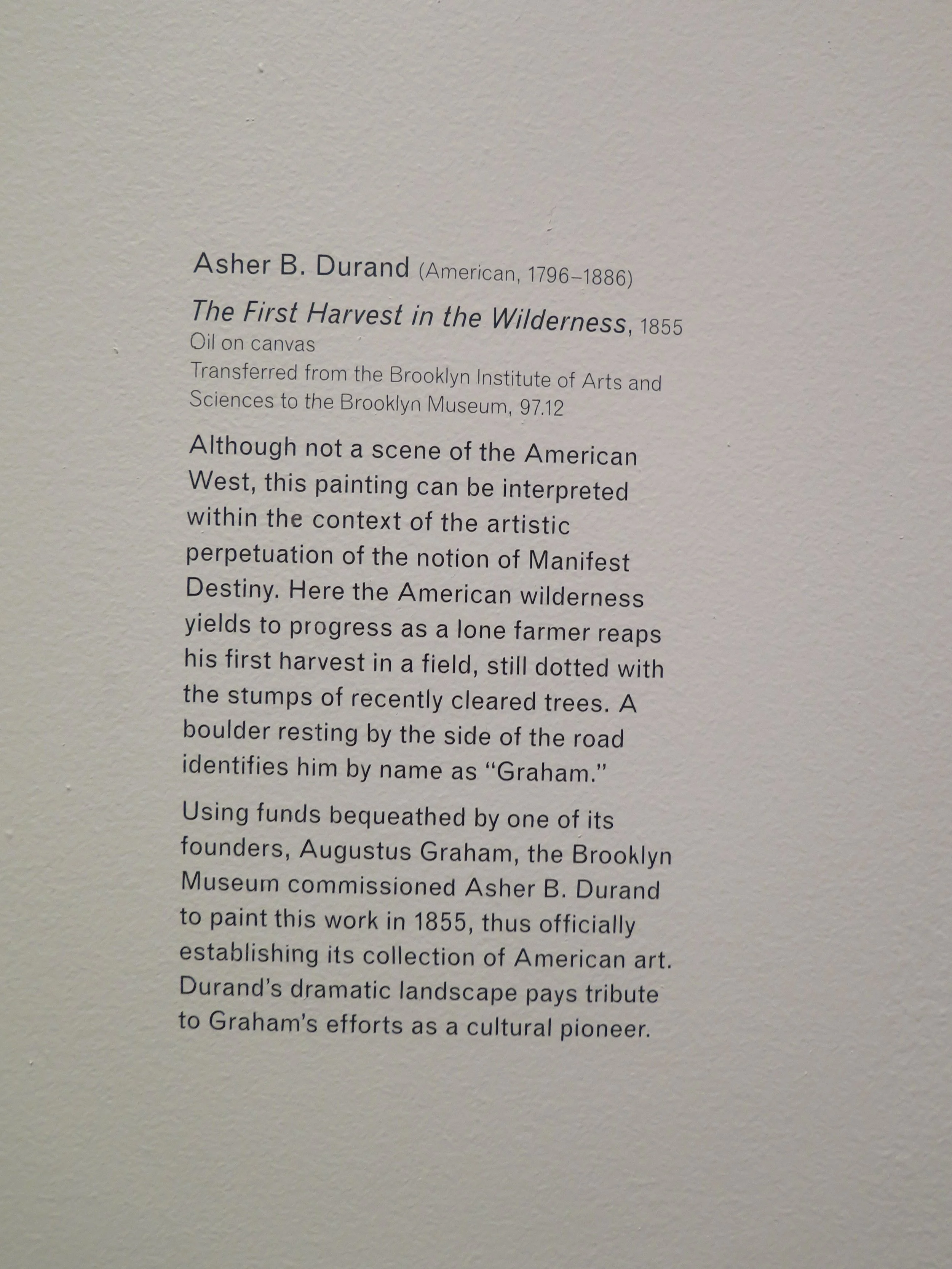
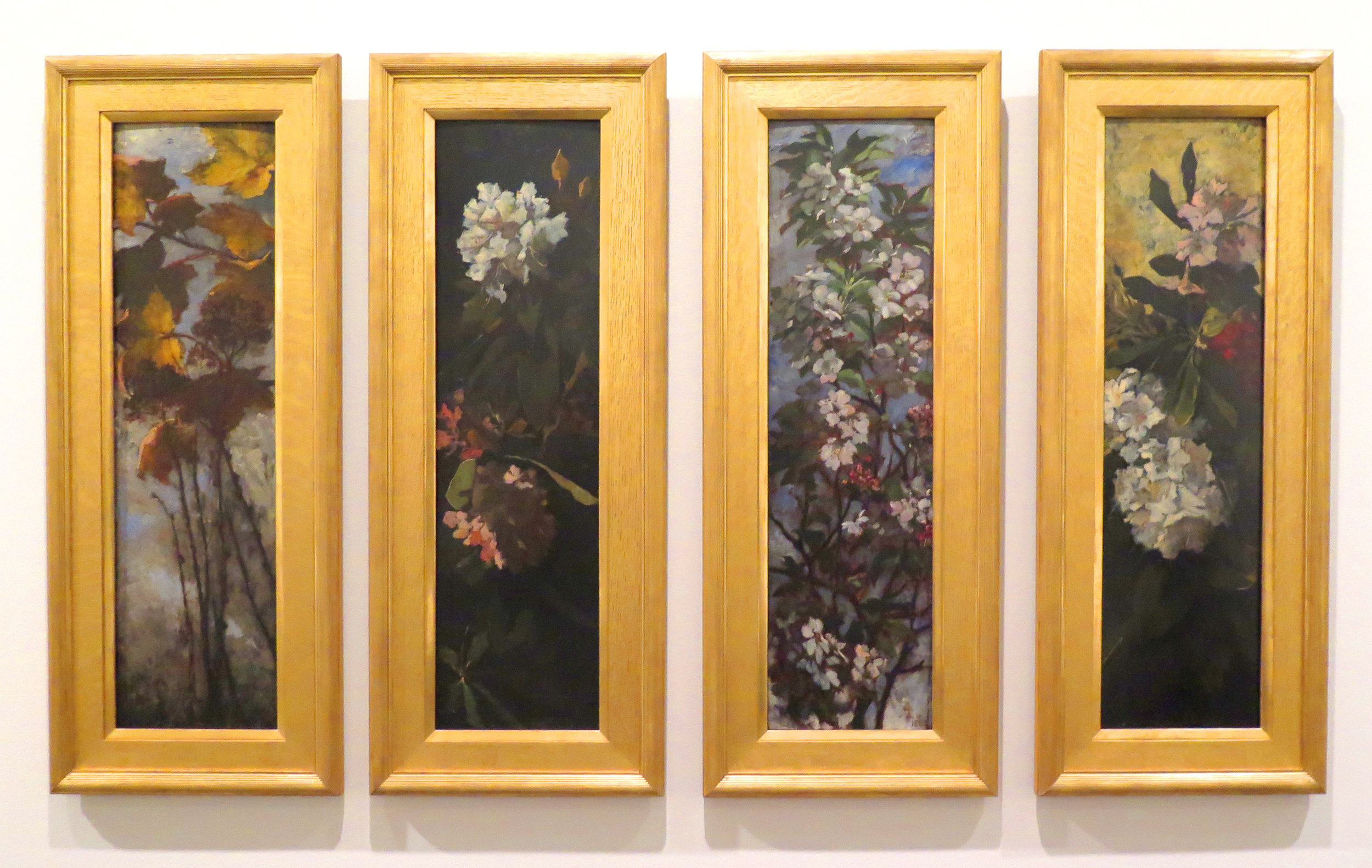
ELIZABETH BOOTT DUVENECK (1846–1888)
Untitled (Autumn Foliage, Rhododendrons, Apple Blossoms, Rhododendrons), 1882, oil on wood, four panels, ~36 x10 inches; Five custom- made replica frames, circa 1890s, gilded wood: reeded outer molding, gilded oak cassetta, gilded bevel liner.
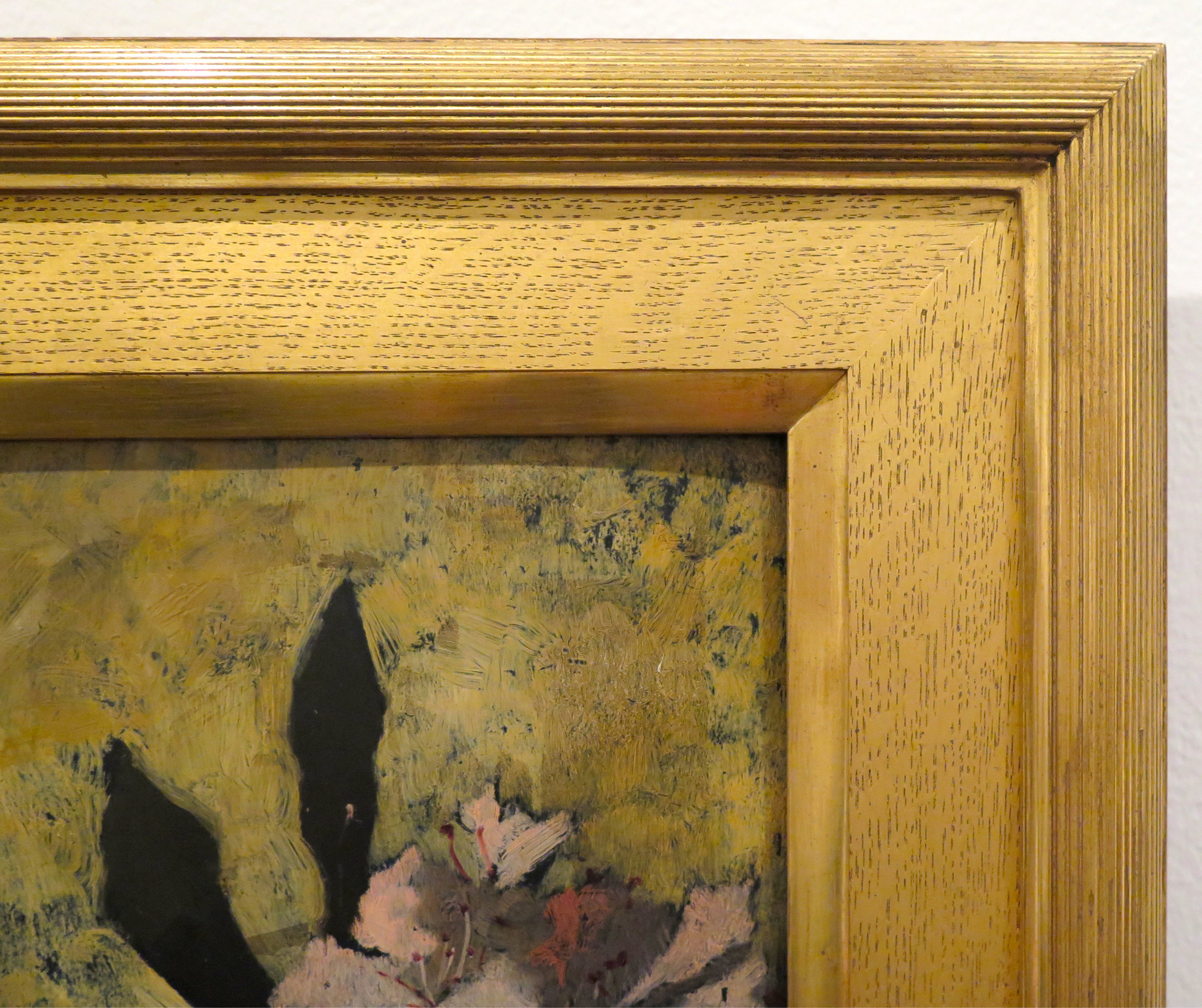

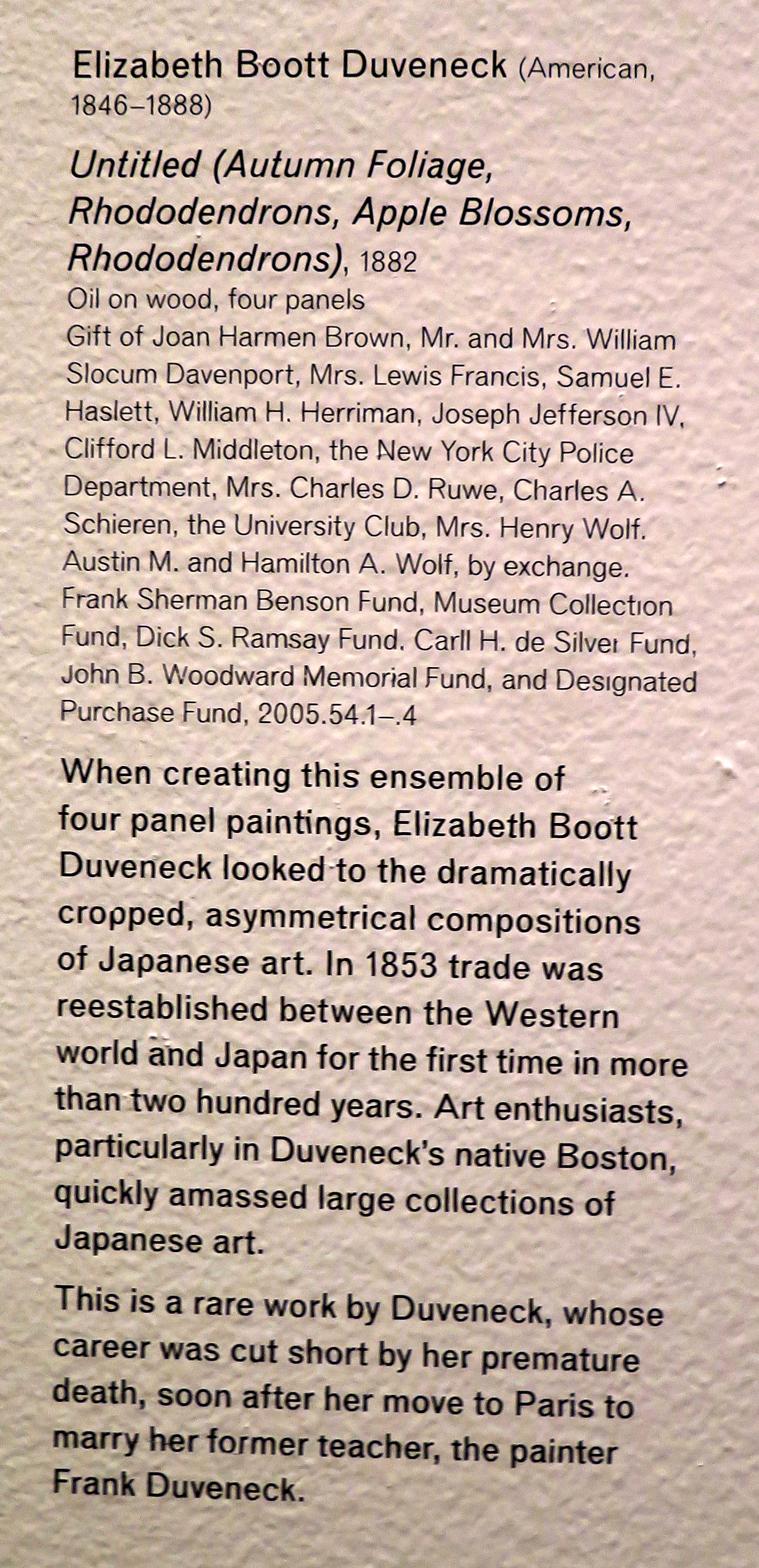
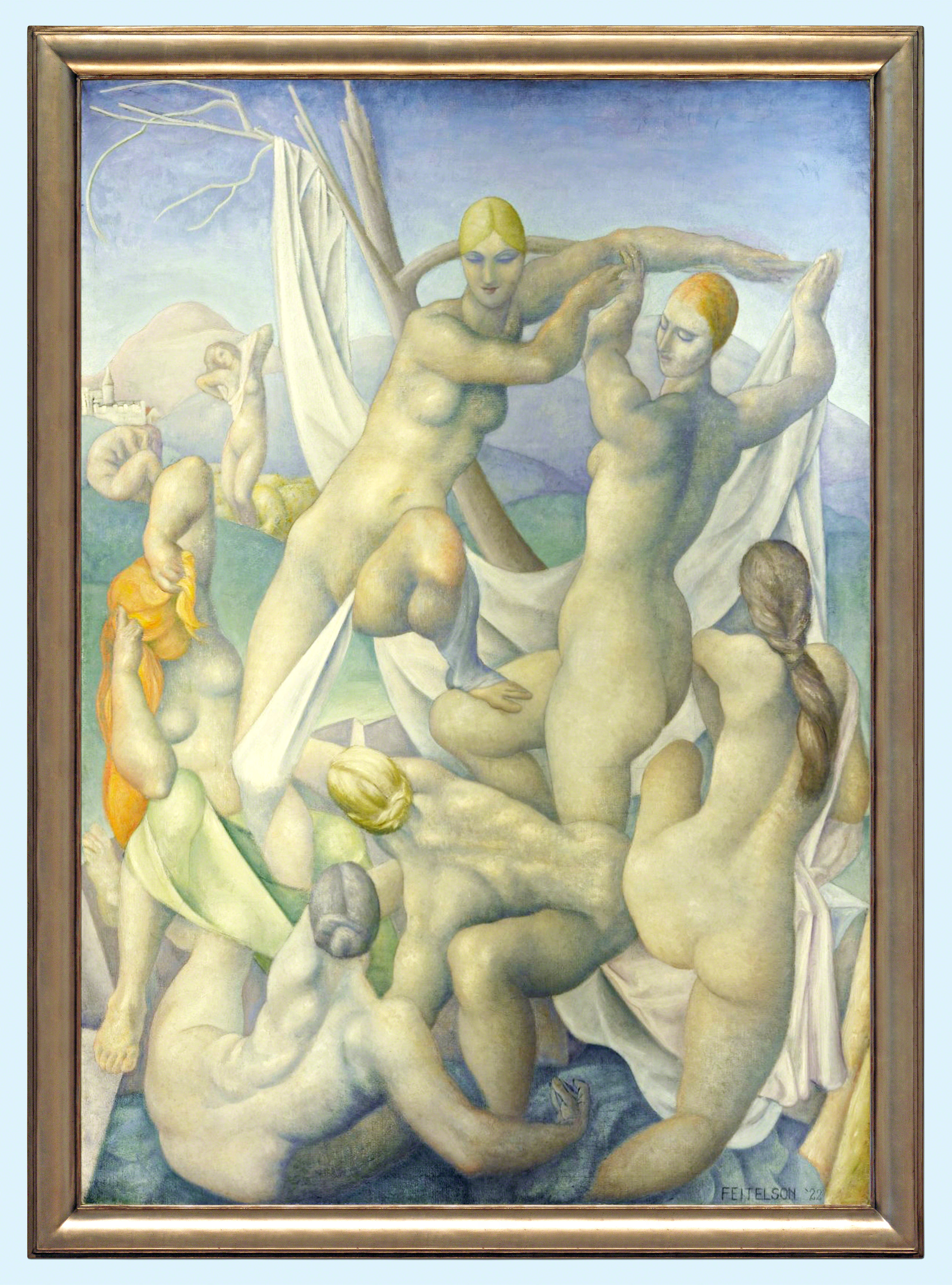
I. LORSER FEITELSON (1898–1978)
“Diana at the Bath”, 1922, oil on canvas, 98-1/2" x 69-3/8" Custom-made variation of c. 1930s American Modernist painting frame, wide reverse wave profile, water gilded and patinated palladium leaf on wood. Molding Width: 3-3/8” "Like many 1920s figure painters, Lorser Feitelson attempted to interpret the ideal, or perfected, human form in a distinctly modern way. In this mythological subject, he based the exuberantly contoured figures and complex, dance-like composition on the style of sixteenth-century Italian Mannerism and its nineteenth-century French heir, Jean-Auguste-Dominique Ingres. Working in Paris, Feitelson no doubt was aware that Picasso had already moved in this classical direction, creating beautifully outlined figures inspired by classical sculpture and Renaissance painting. Although the painting’s chalky, fresco-like colors also refer to Renaissance art, the figures are lithe, athletic, and unmistakably modern. By the time he presented this painting to the Museum in 1924, Feitelson lived on Prospect Place in Brooklyn." — Brooklyn Museum, permanent collection label.
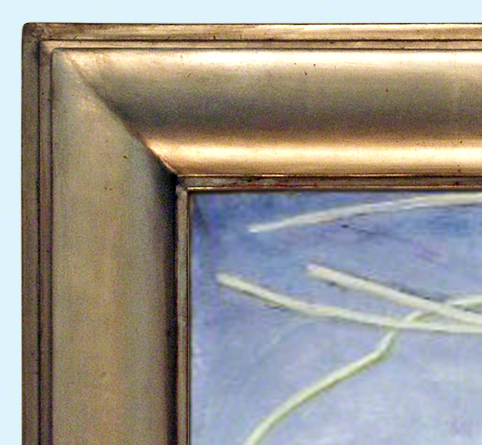
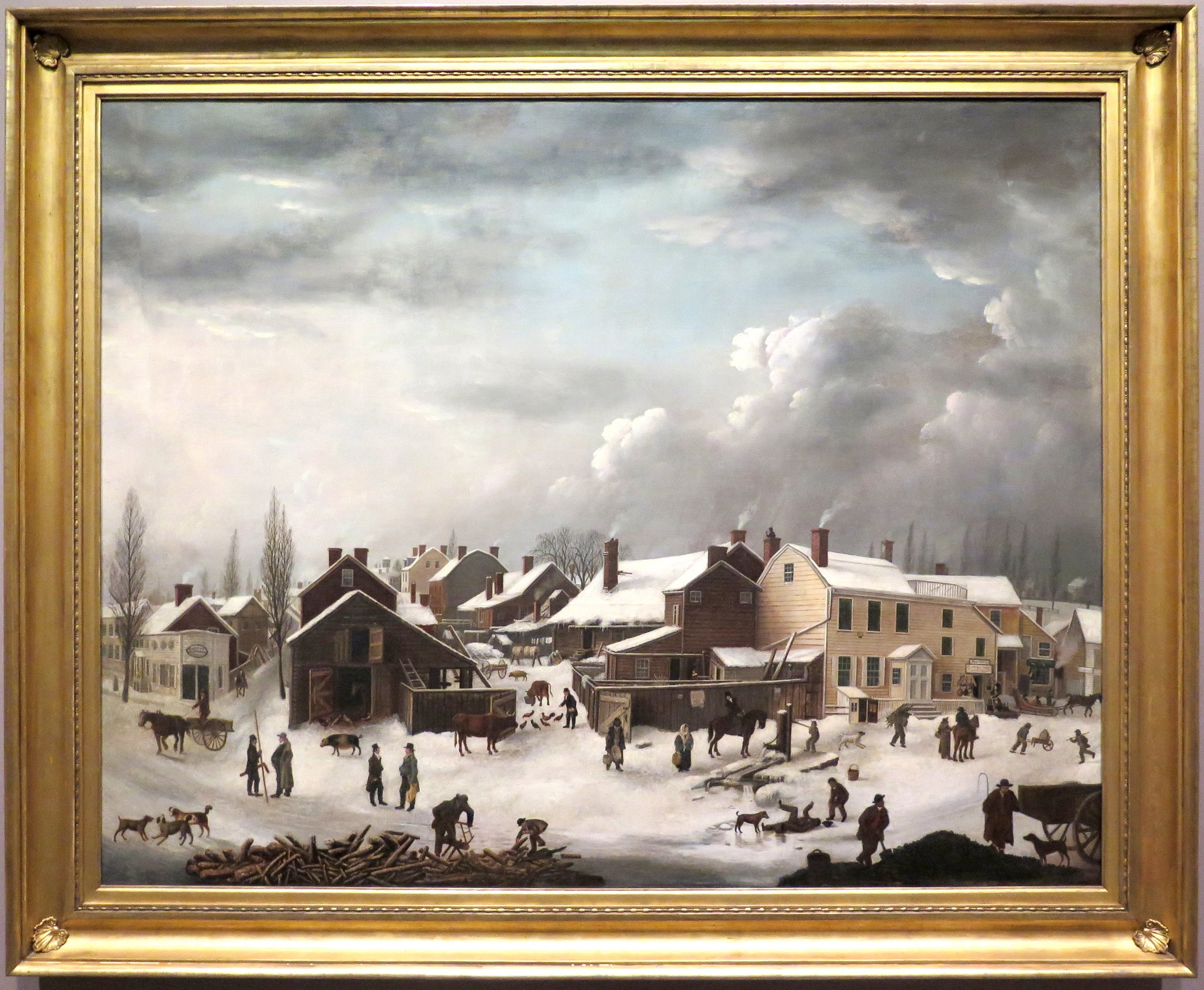
FRANCIS GUY (1760 – 1820)
Winter Scene in Brooklyn, ca. 1819-1820. oil on canvas, 58-3/8 x 74-9/16 inches. First-quarter 19th-century American frame; carved gilded wood with applied ornament, molding width 8 in. “Painting transferred from the Brooklyn Institute of Arts and Sciences to the Brooklyn Museum, 97.13. By the time the Brooklyn Institute (the Museum’s forerunner) acquired this work in 1846, downtown Brooklyn was already much changed from the village depicted by Francis Guy. This picturesque cityscape appealed to those living in the rapidly developing East. Observers at the time noted that at the heart of the image was the “old-fashioned” Dutch-style barnyard of Abiel Titus. This feature greatly contrasted with the elegant houses originally included at left, before the painting was damaged by fire in 1881. Painted from the vantage point of the artist’s second-story window facing Front Street, it included what were considered to be lifelike portraits of many of his neighbors. A printed “key” identifying them accompanied this work in its 1820 exhibition. [see below]”—museum label
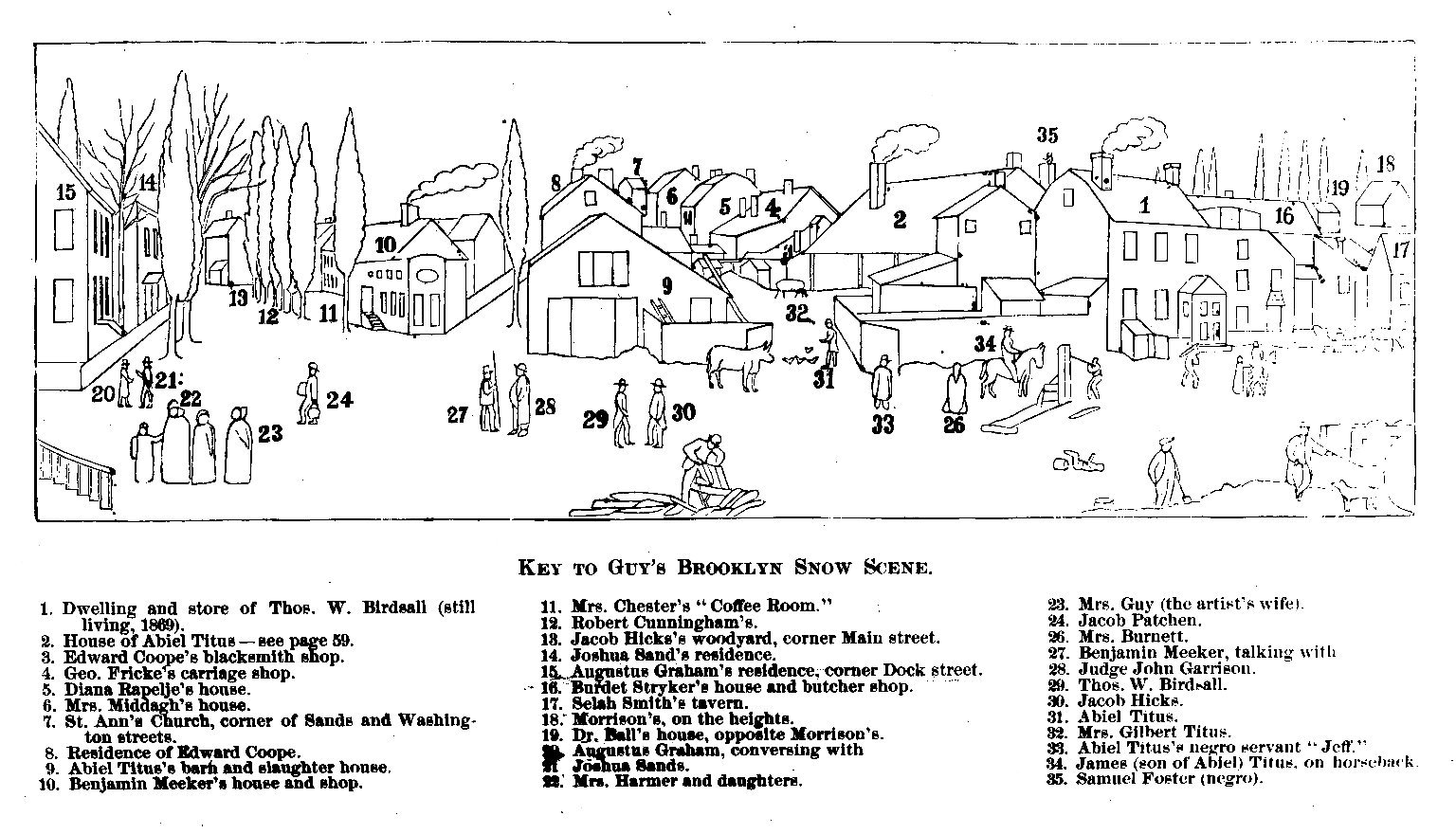

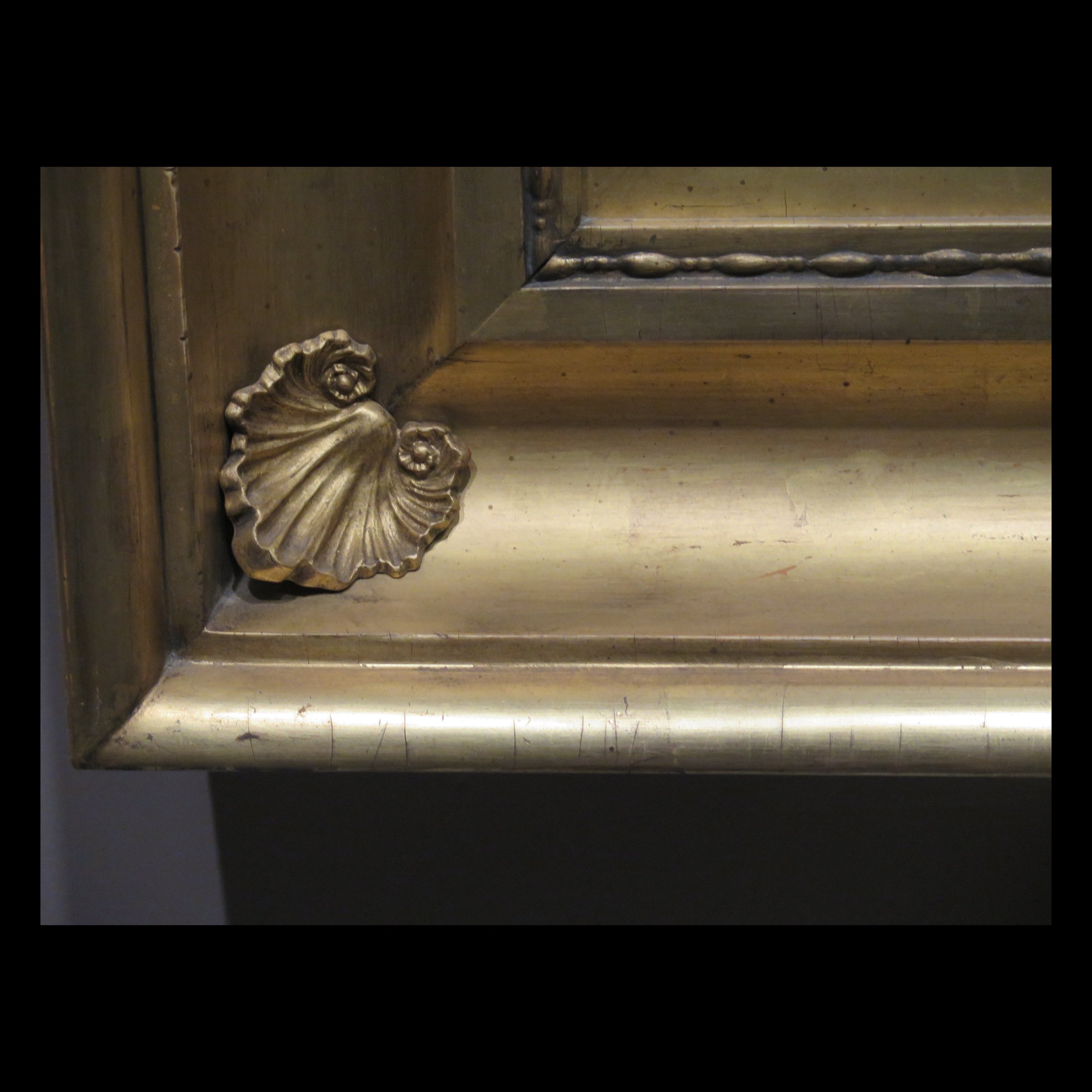
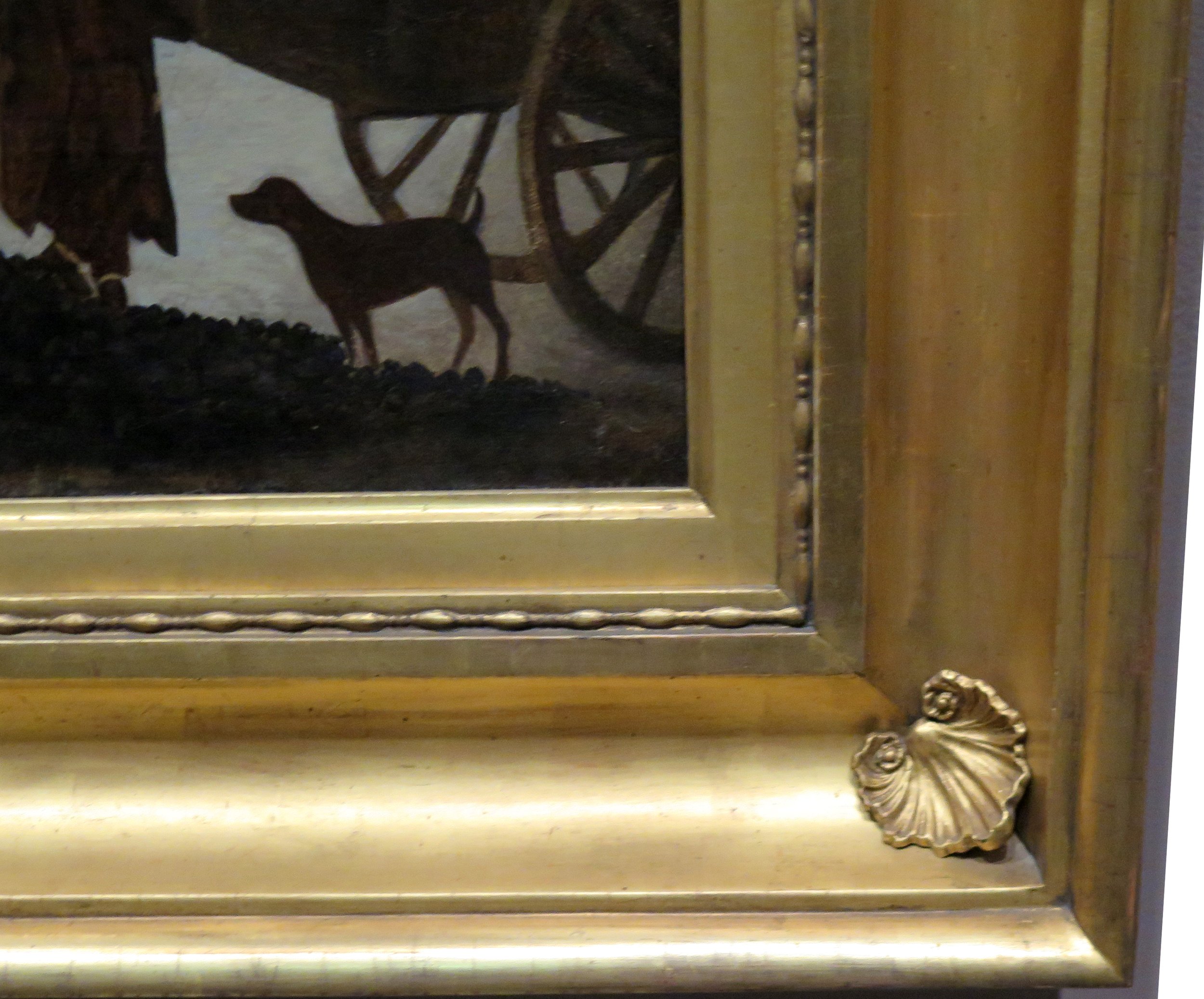
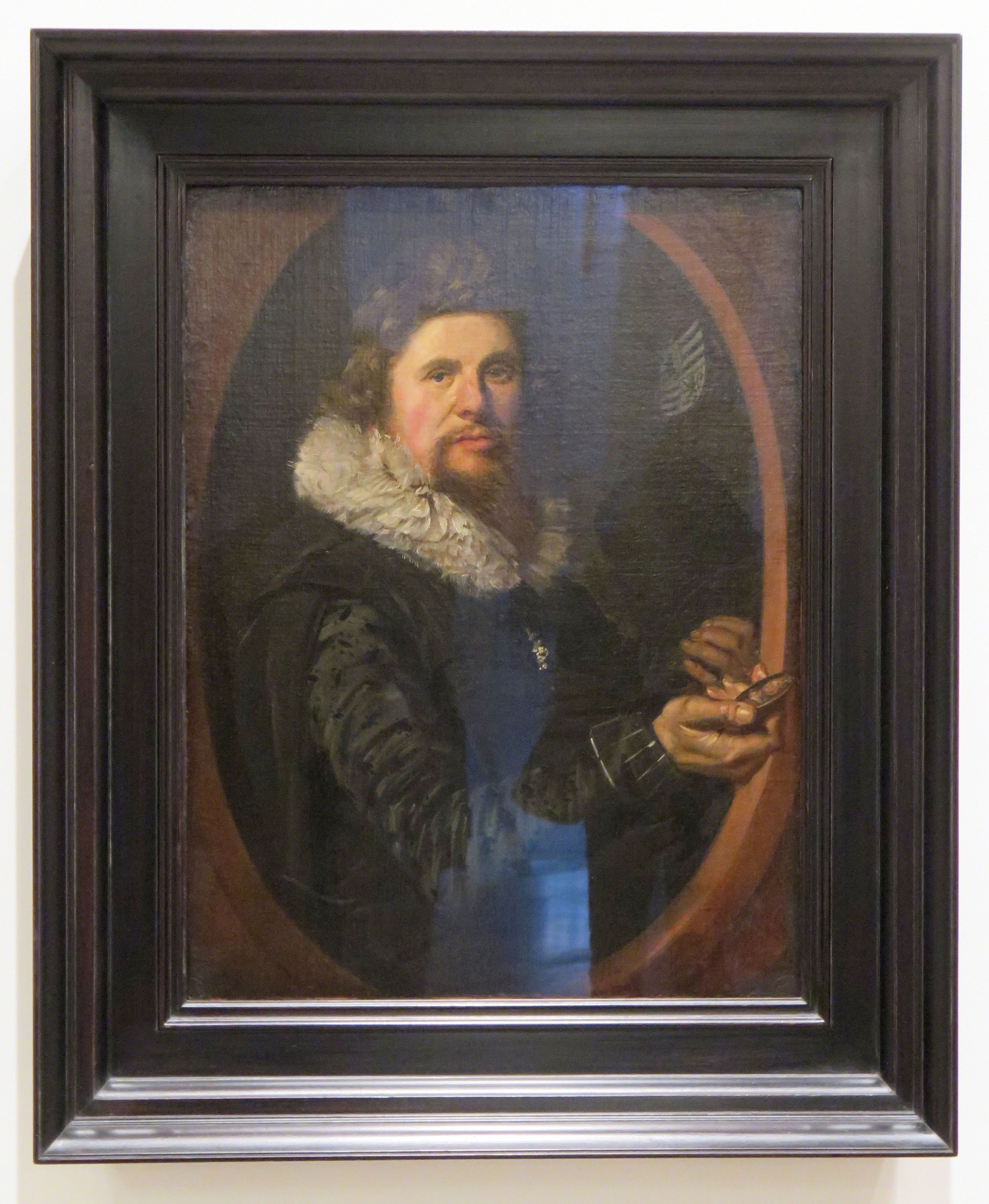
FRANS HALS (circa 1580–1666)
Portrait of a Man, circa 1614-15, oil on canvas, 29 x 21-3/4 in. Custom-made Replica c. 1611-13 Dutch painting frame, milled wood, stained and patinated to period ebonized finish, molding width: 5-1/2 in.; molding depth from wall: 4-1/4 in. Brooklyn Museum, painting Gift of the executors of the Estate of Colonel Michael Friedsam, 32.821
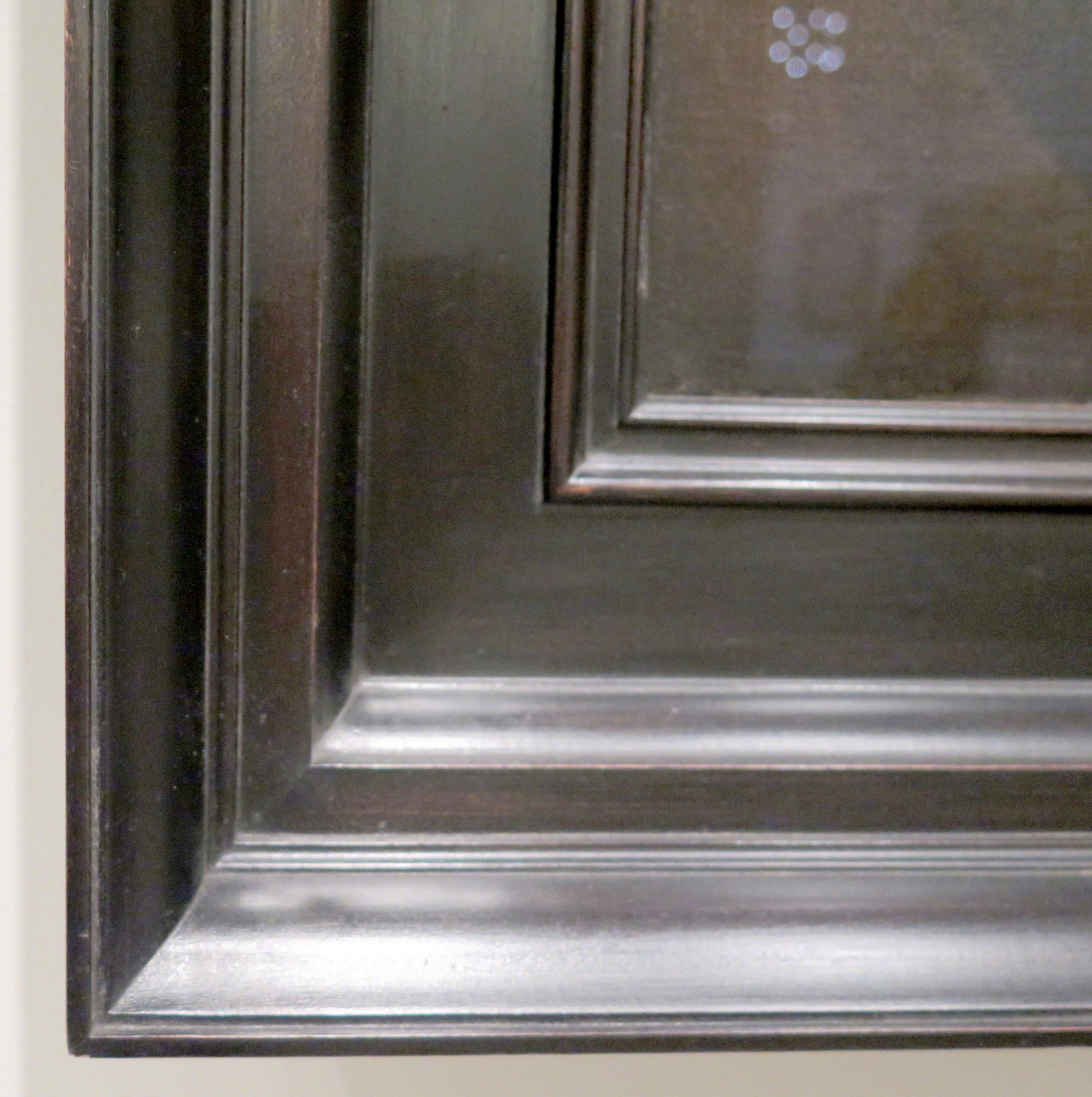
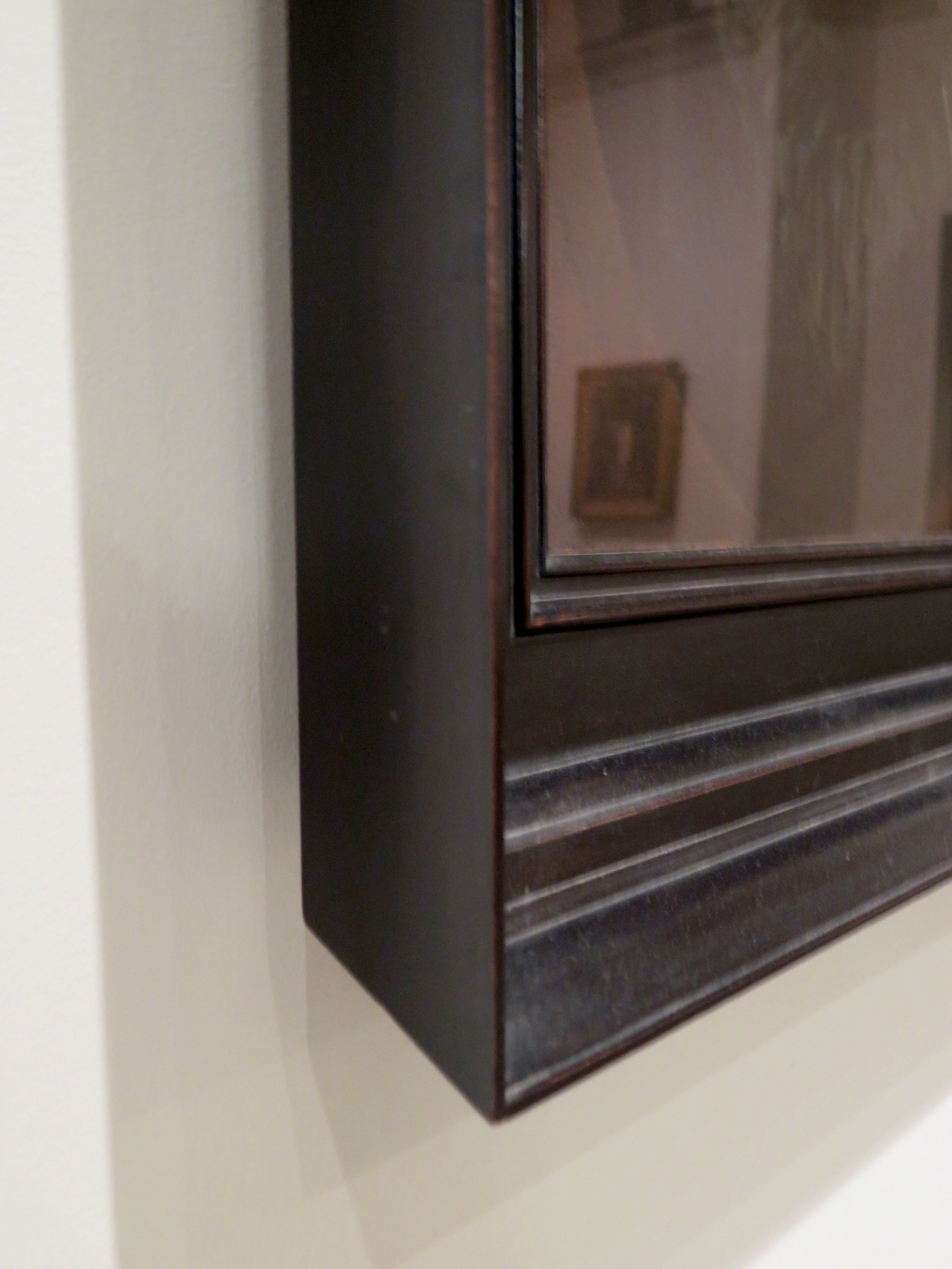
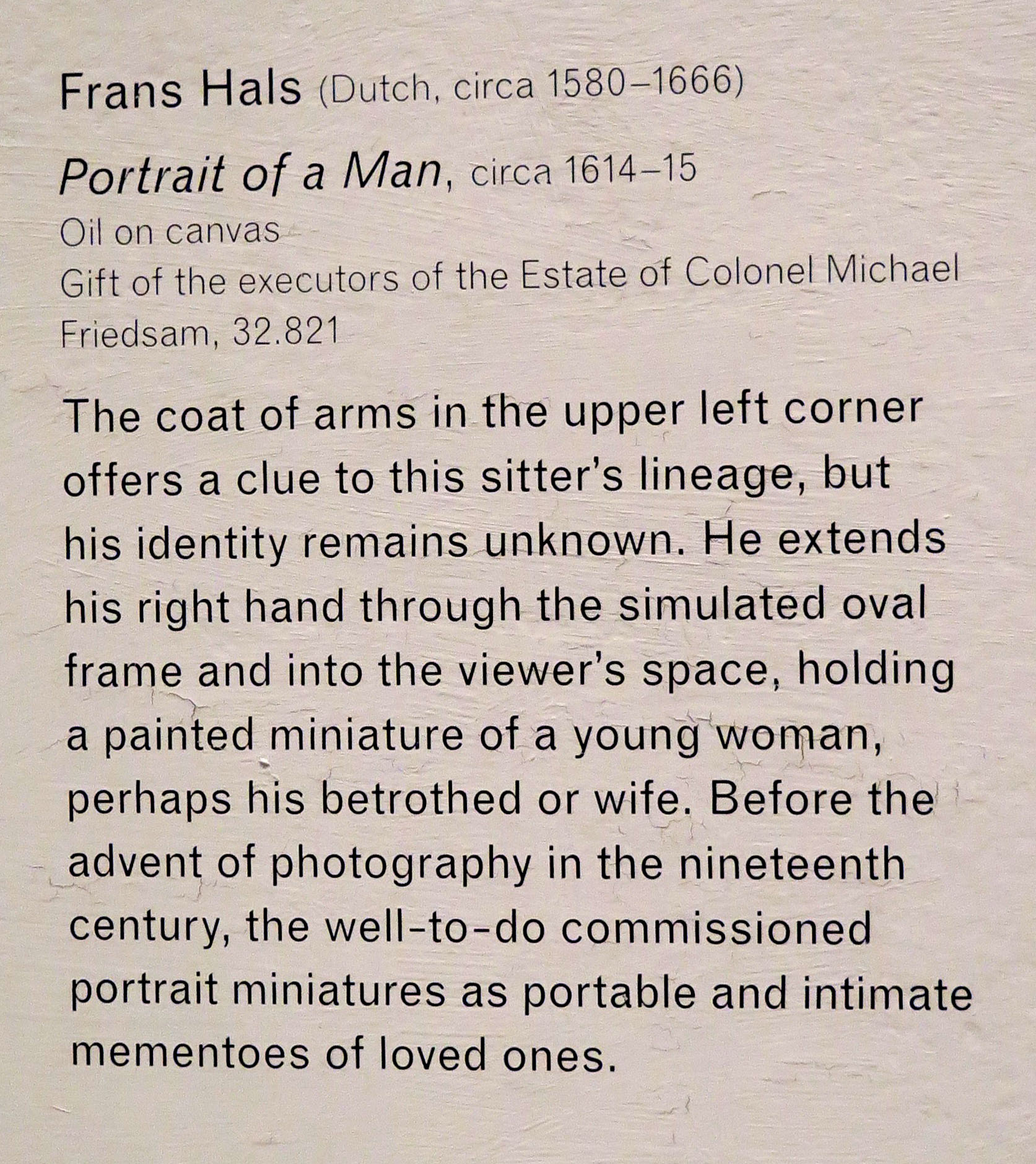
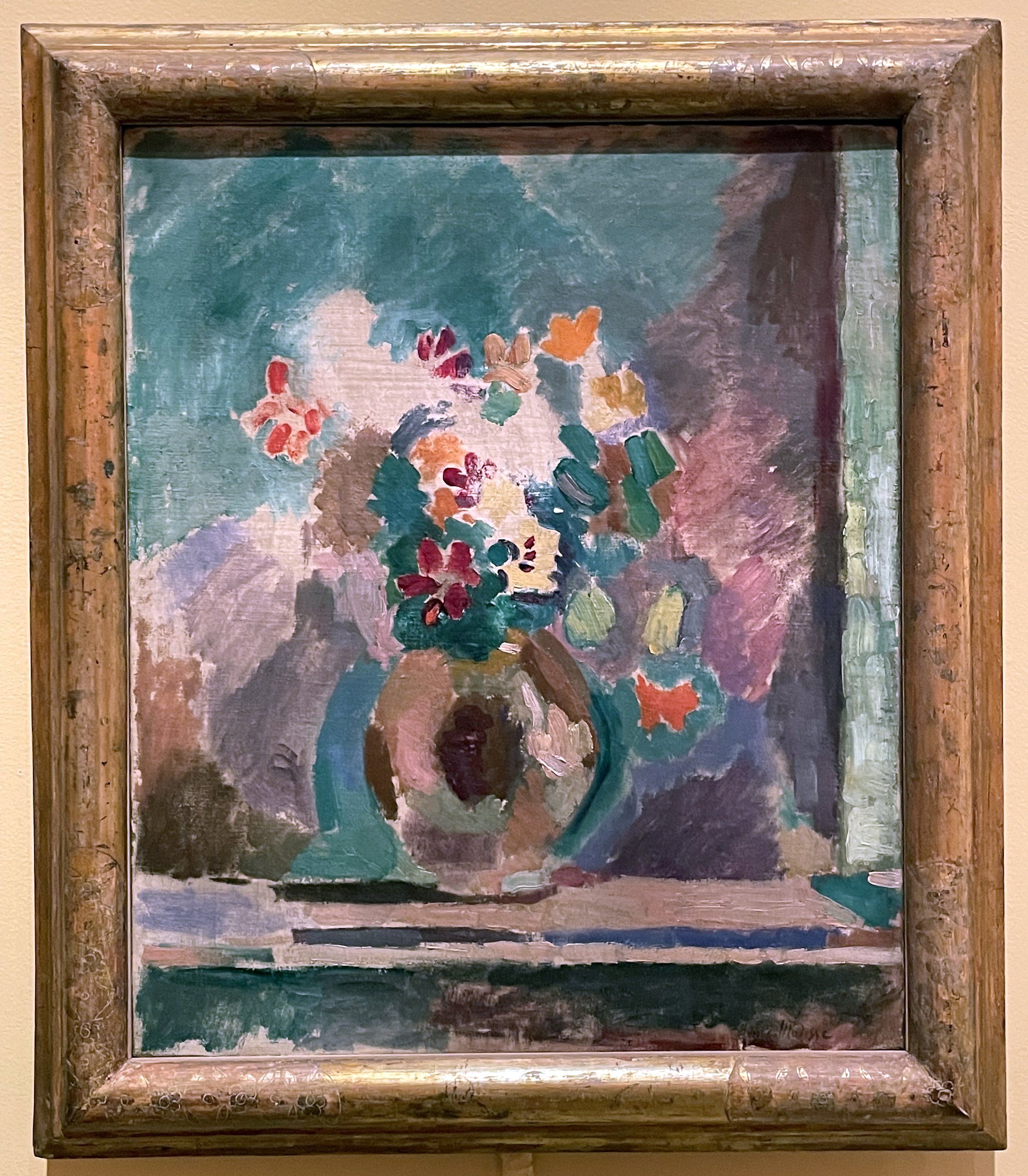
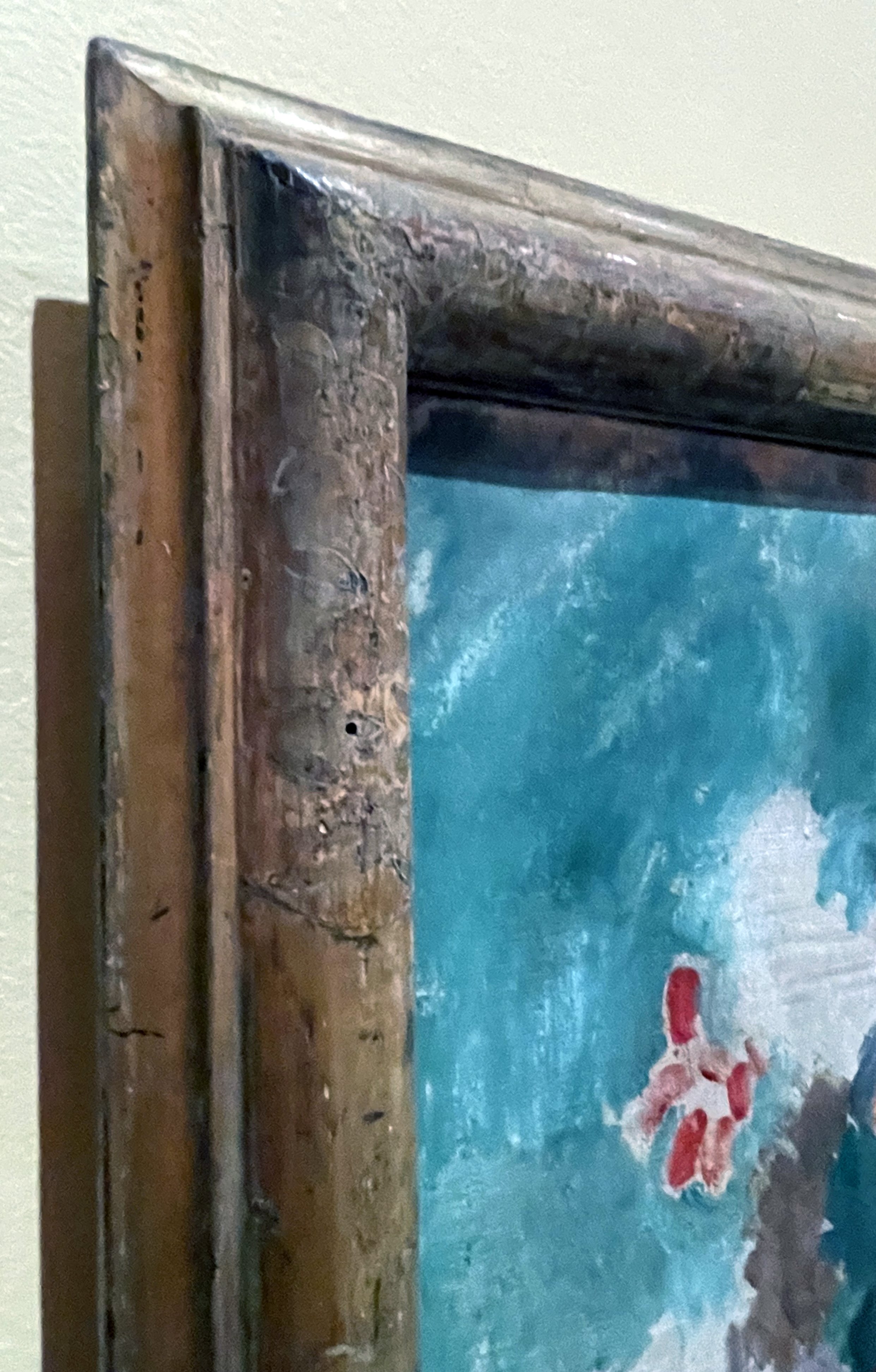

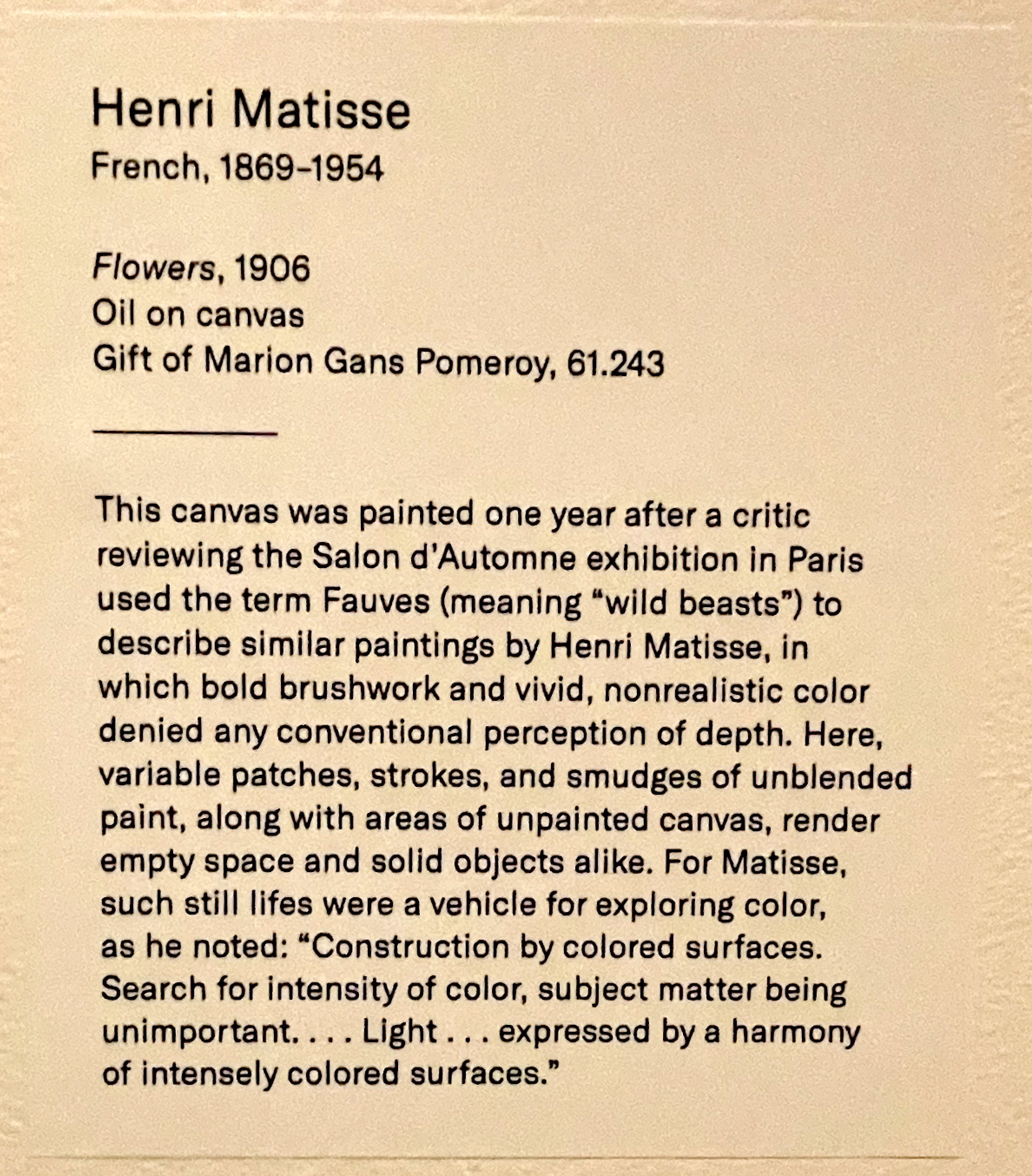

CLAUDE MONET (1840–1926)
The Islets at Port-Villez (Les Iles à Port-Villez), 1897, oil on canvas, 32-3/16 x 39-3/4 in. One of four Monet paintings framed by Gill & Lagodich for the Brooklyn Museum, 19th-century gilded wood frame, molding width 4-7/8 in.
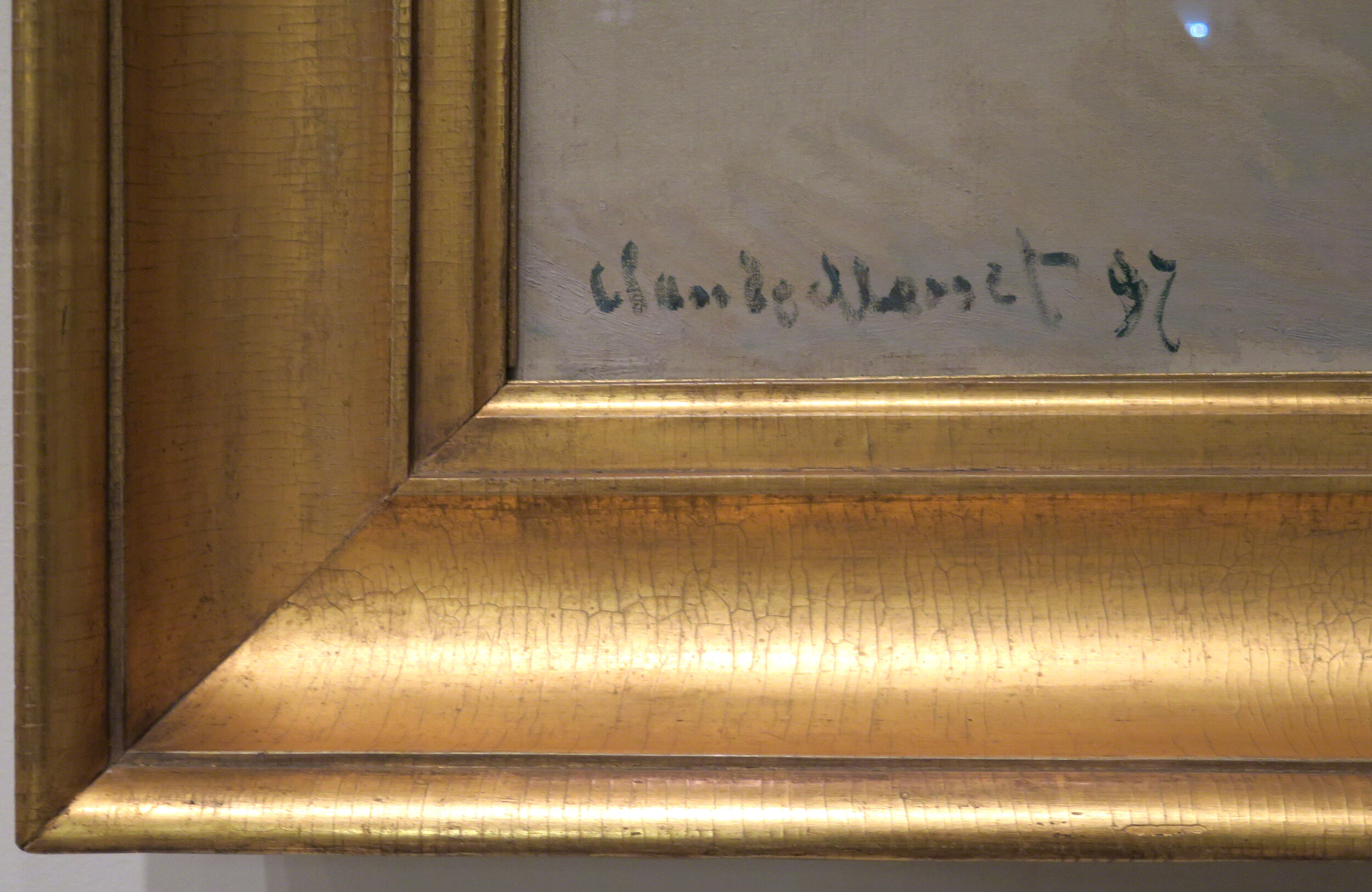
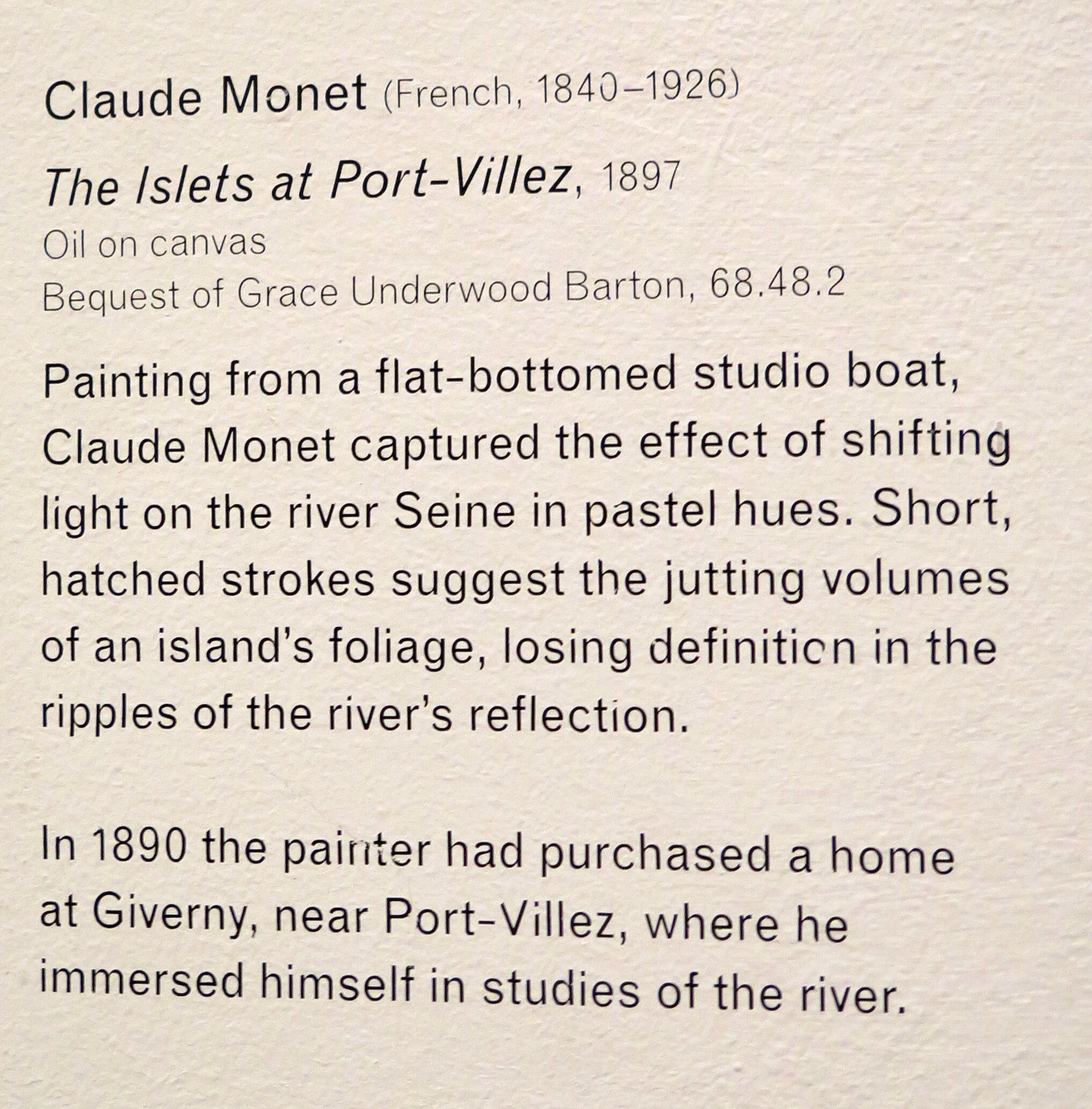
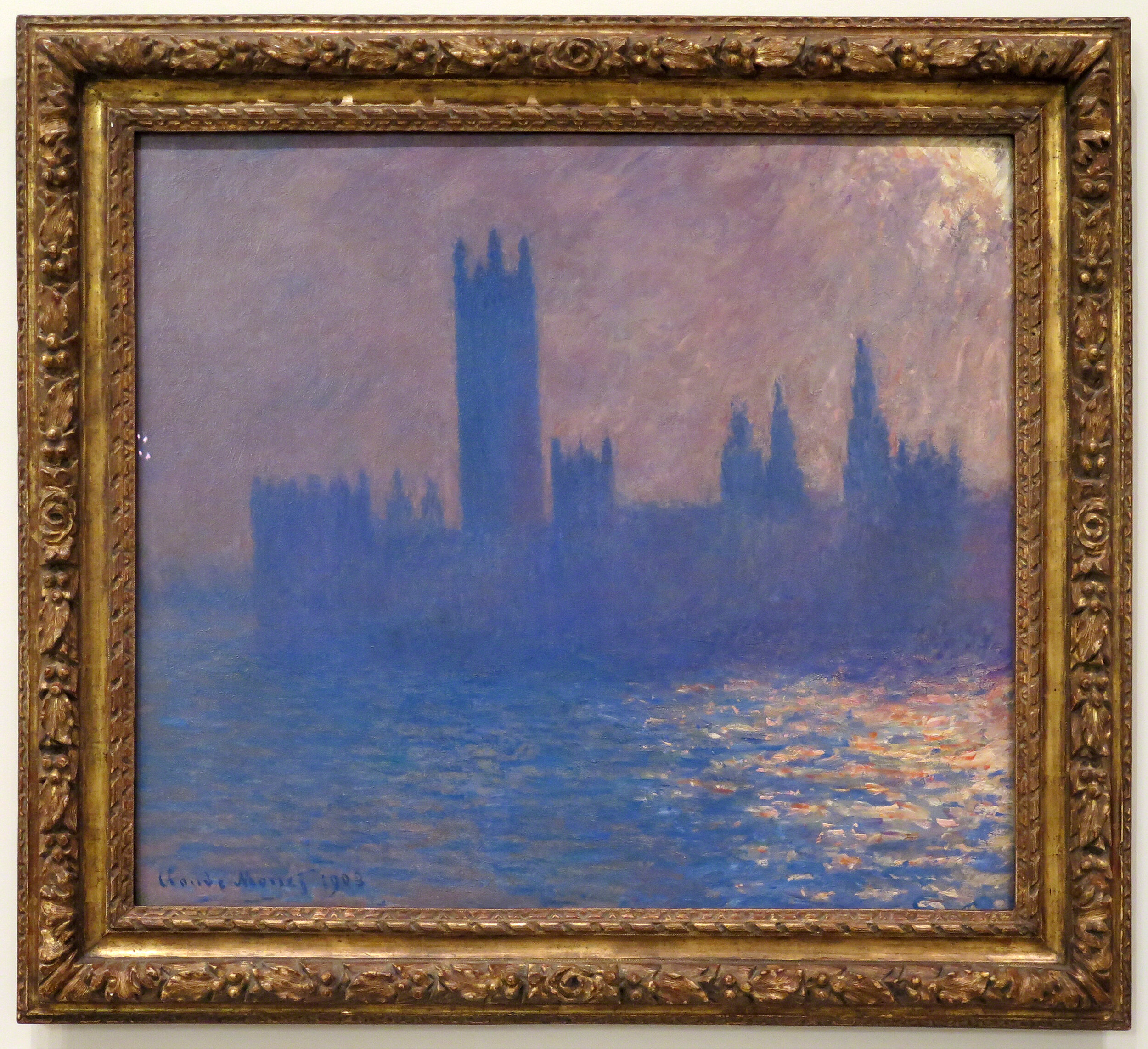
CLAUDE MONET (1840 – 1926)
"Houses of Parliament, Sunlight Effect (Le Parlement, Effet de Soleil)," 1903, oil on canvas, 32” x 36-1/4” One of four Monet paintings framed by Gill & Lagodich for the Brooklyn Museum. 17th-century French Louis XIII gilded hand-carved wood frame. “Intrigued by the challenge posed by the play of water and light, Monet tested himself further by painting the transformative beauty of London’s fog and smoke in several works executed along the banks of the Thames during three winter painting campaigns from 1899 to 1901. Monet stationed himself on the balcony of Saint Thomas’ Hospital, across the river from his subject, substituting one canvas for another—nineteen in all—as changing weather and light conditions dictated. Their neo-Gothic spires blunted by the mauve gloom of late afternoon, the Houses of Parliament emerge as a massive silhouette. Rays of pale sunshine break through the murk in the upper right corner of the canvas and burst across the shimmering waters in overlapping strokes of pink, salmon, and yellow. The painter later reworked the canvas in his Giverny studio in 1903 in preparation for an exhibition the following year.” — Brooklyn Museum, permanent collection label.
